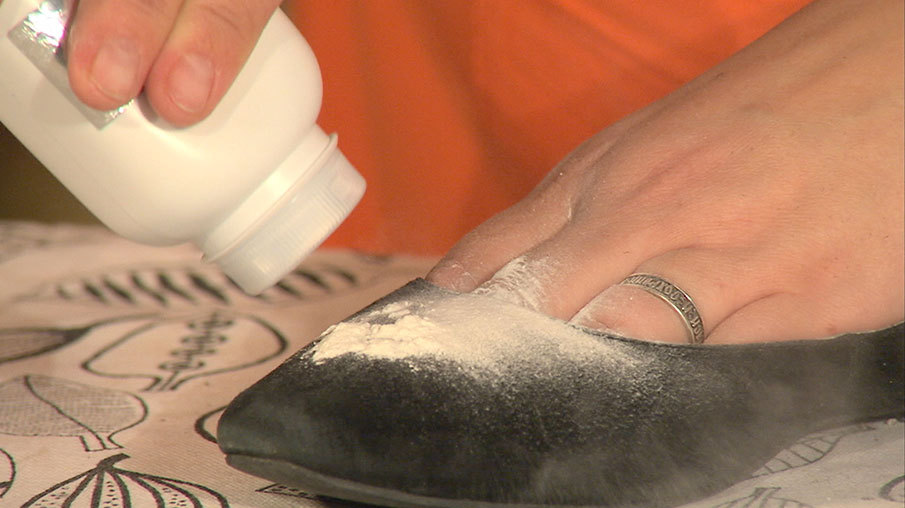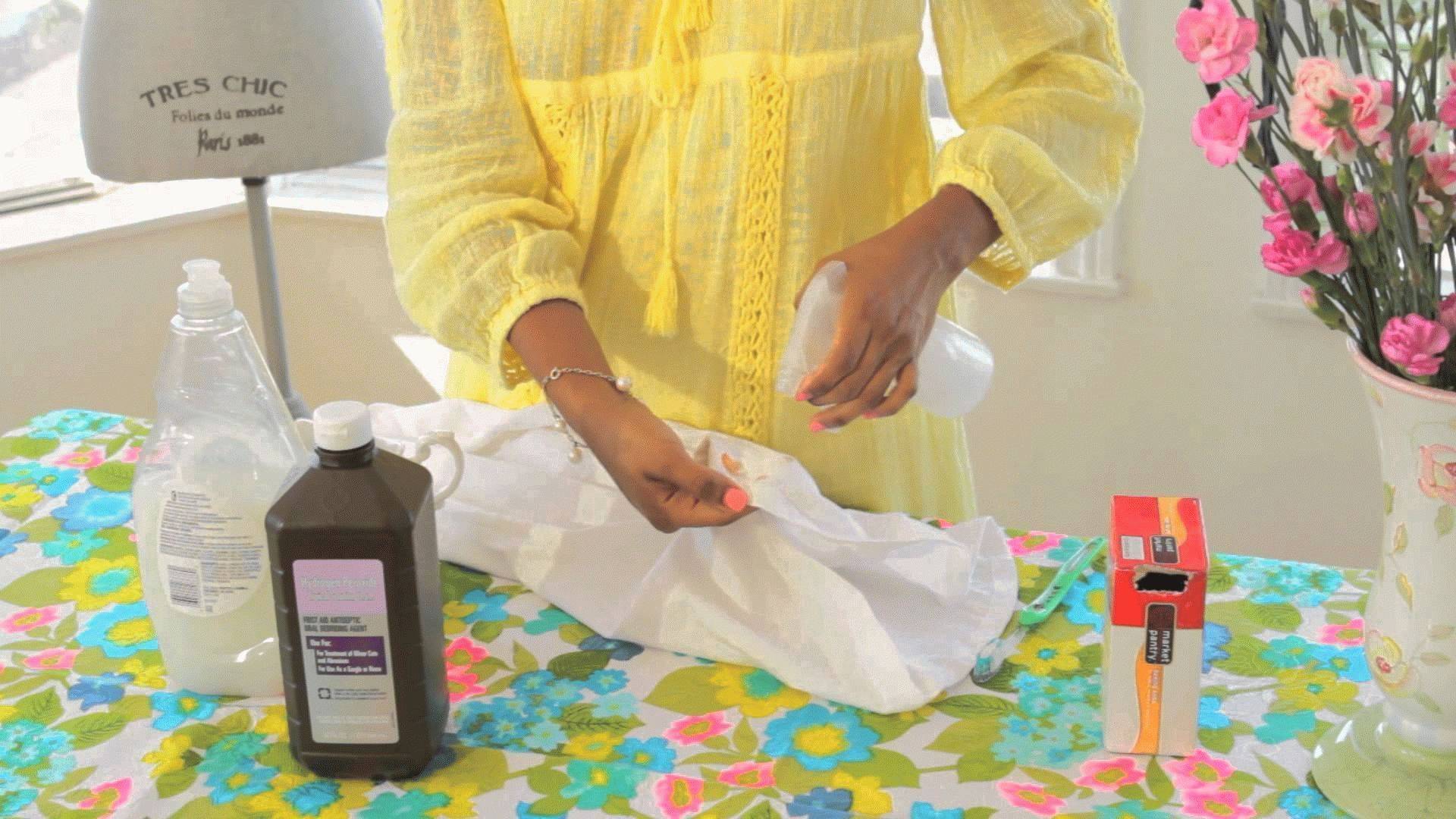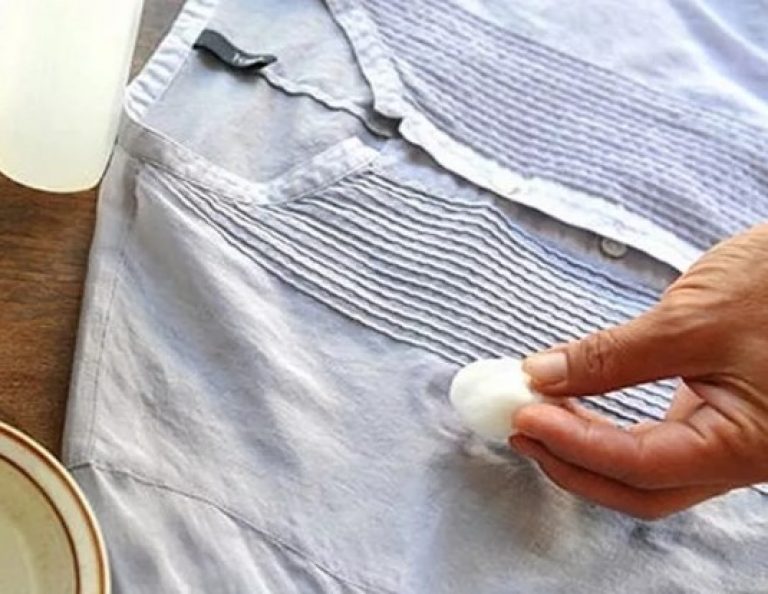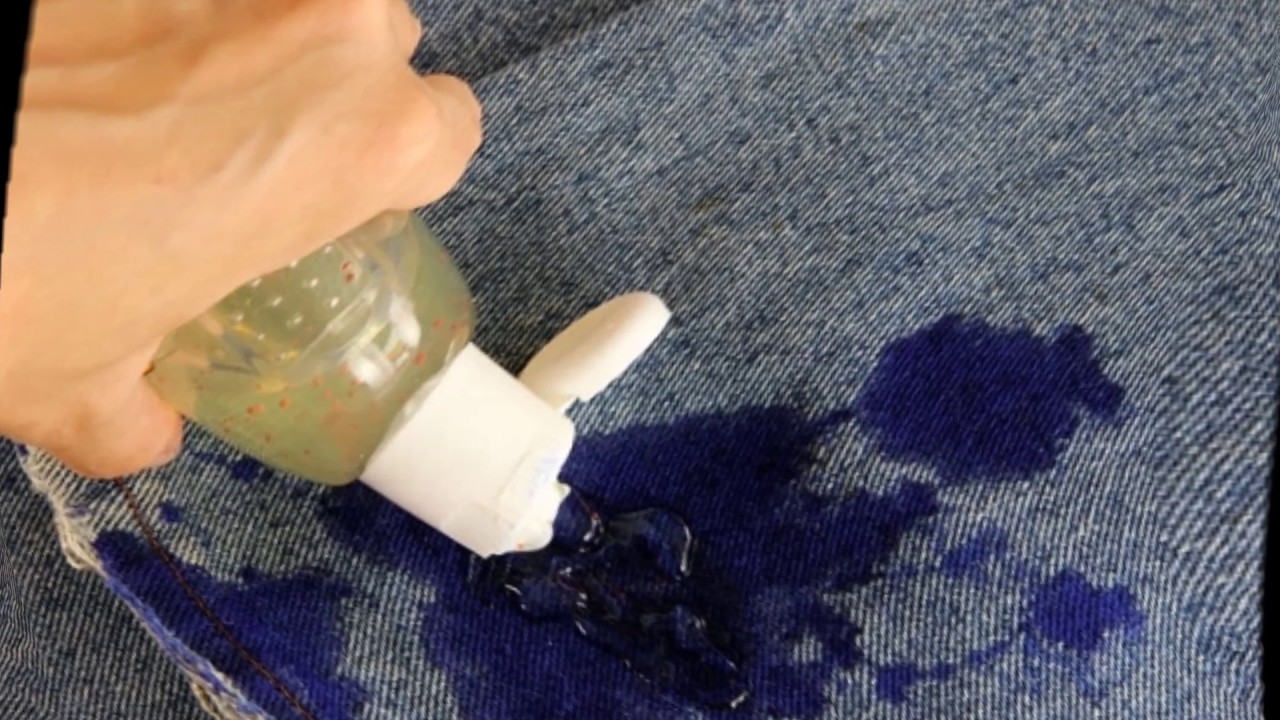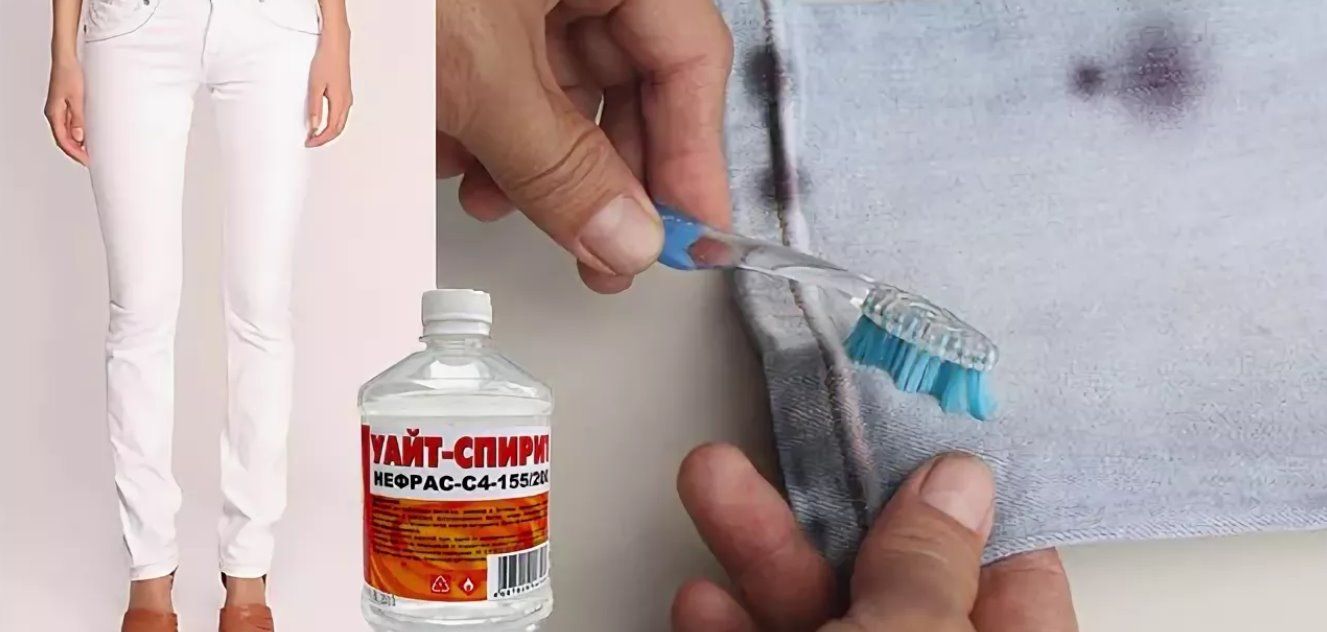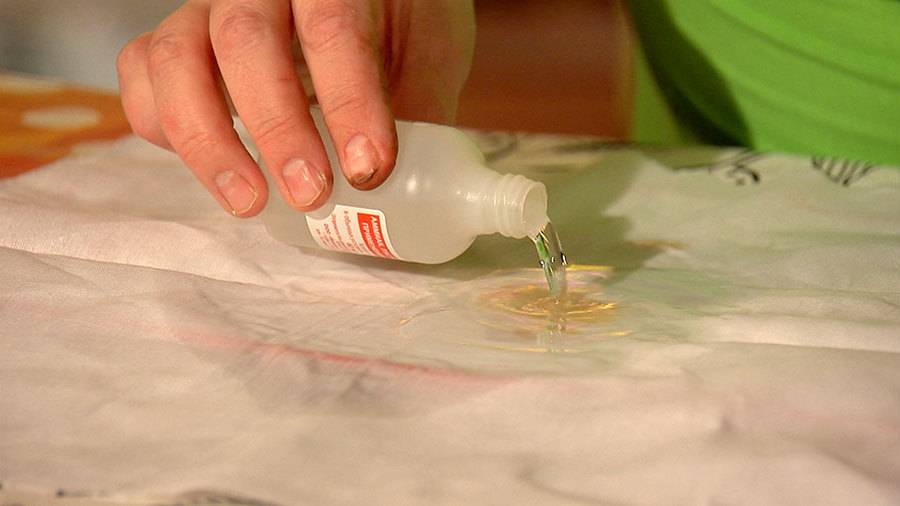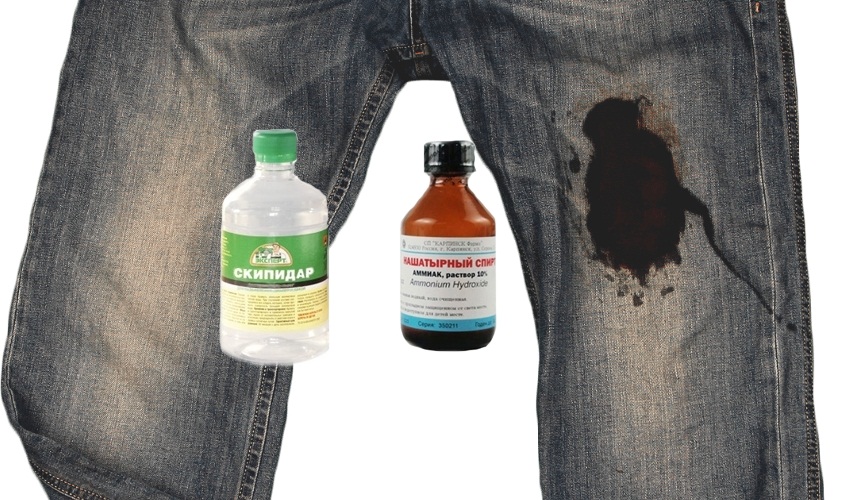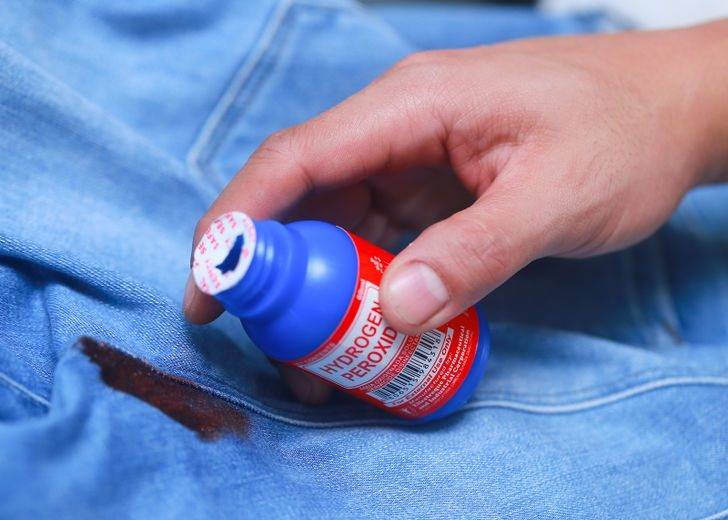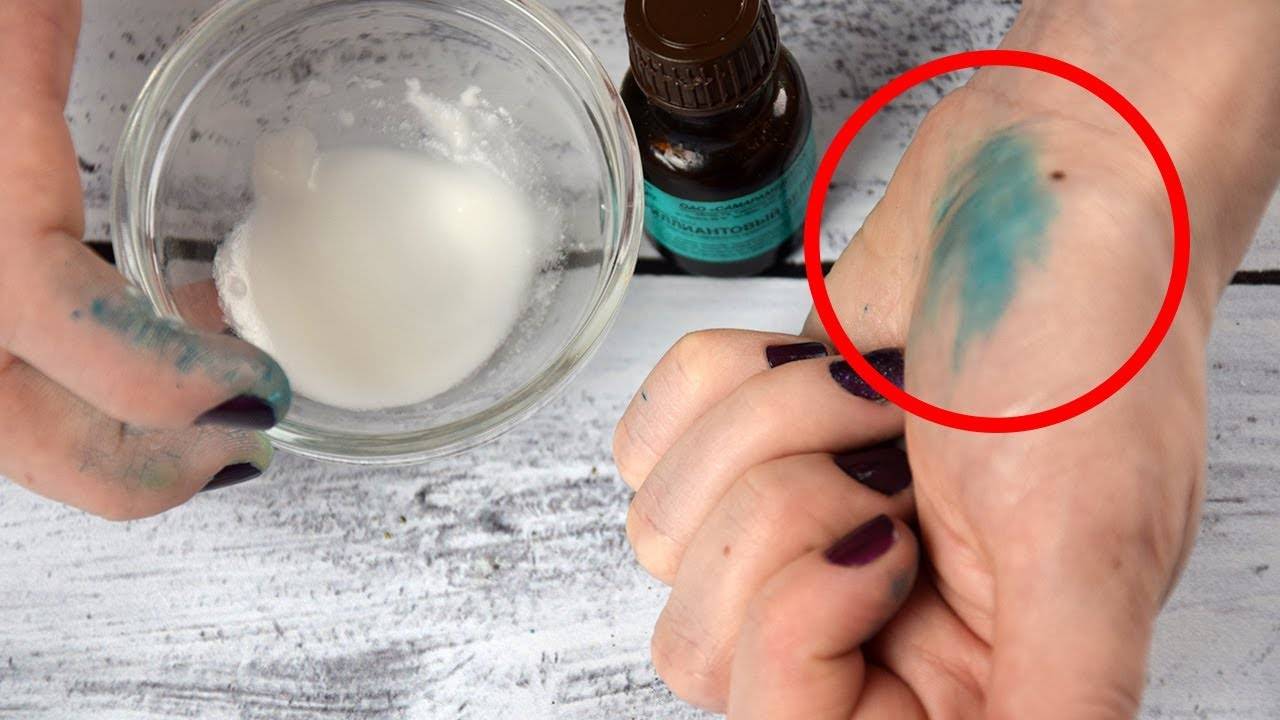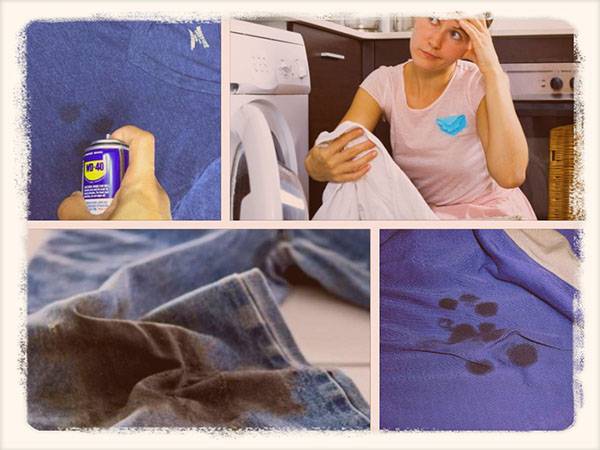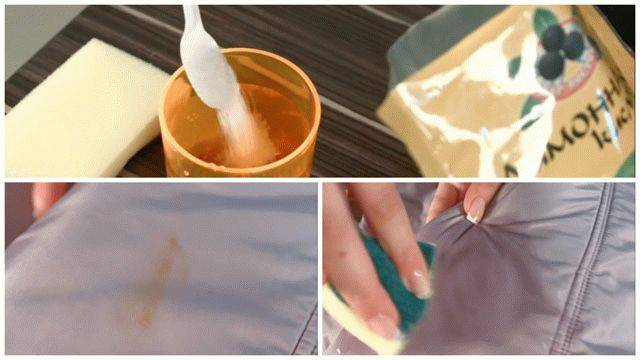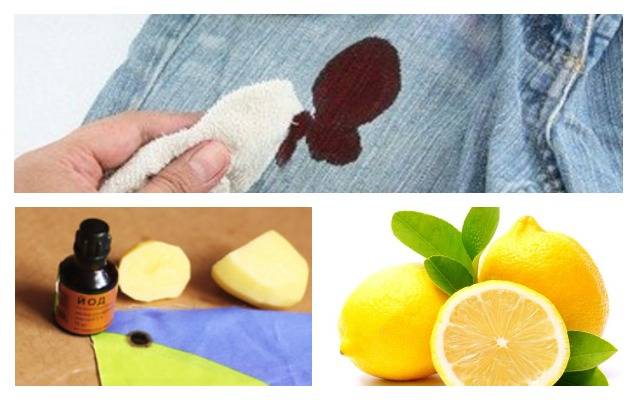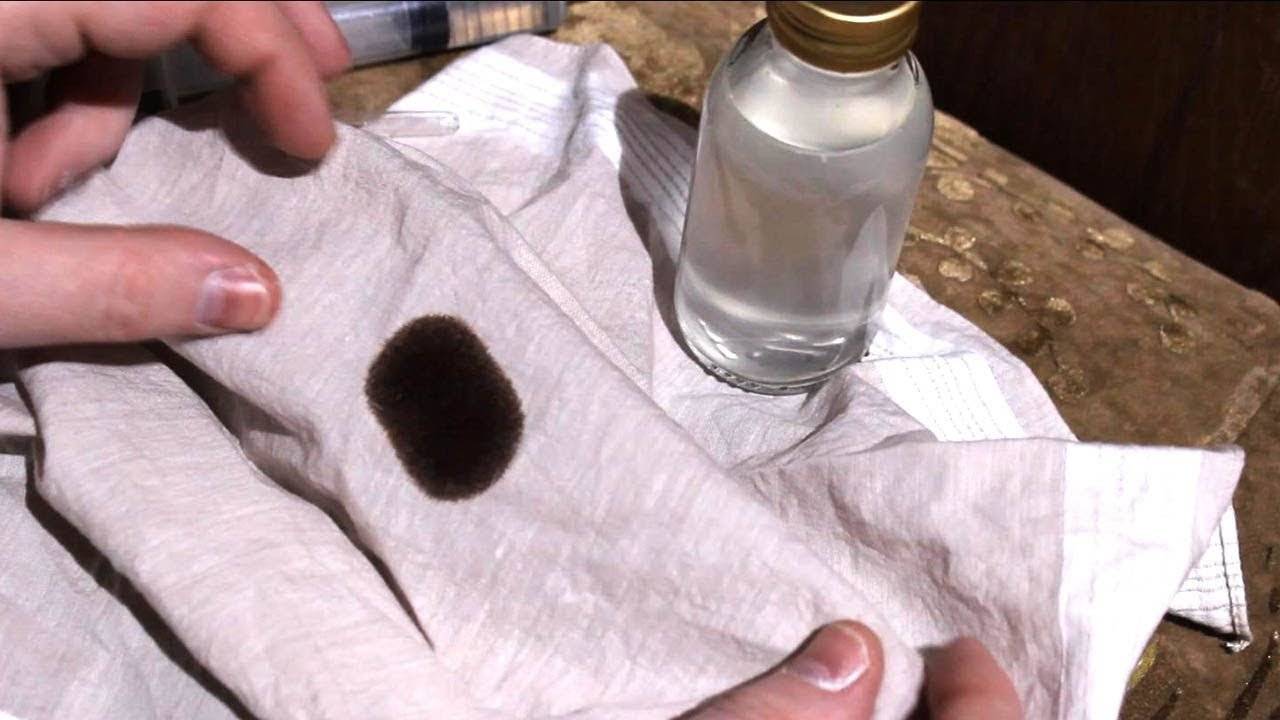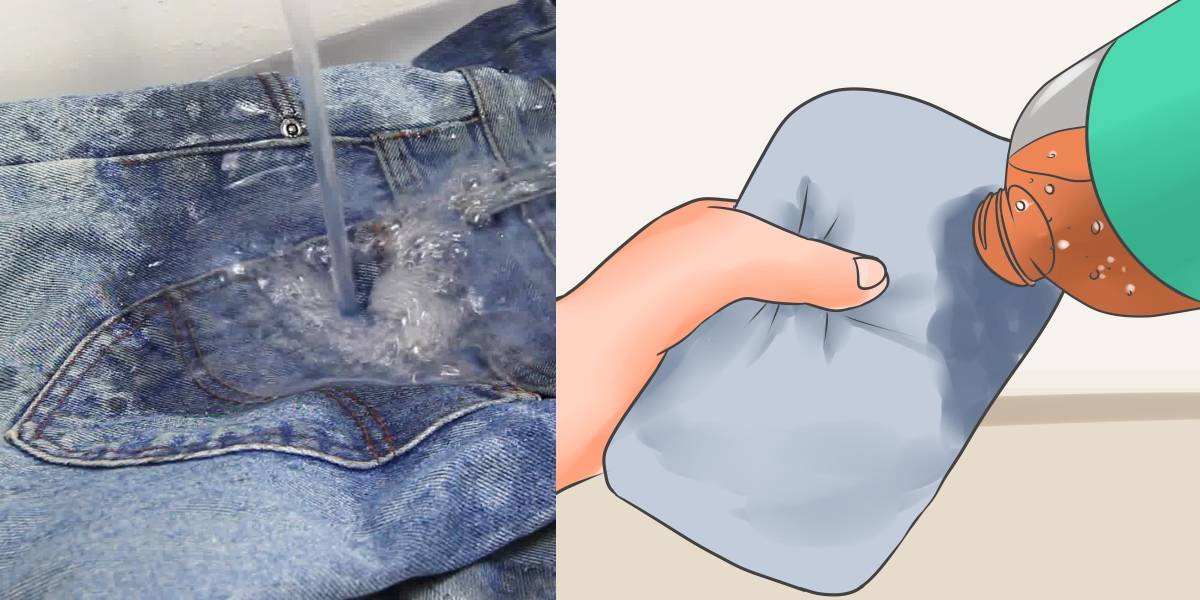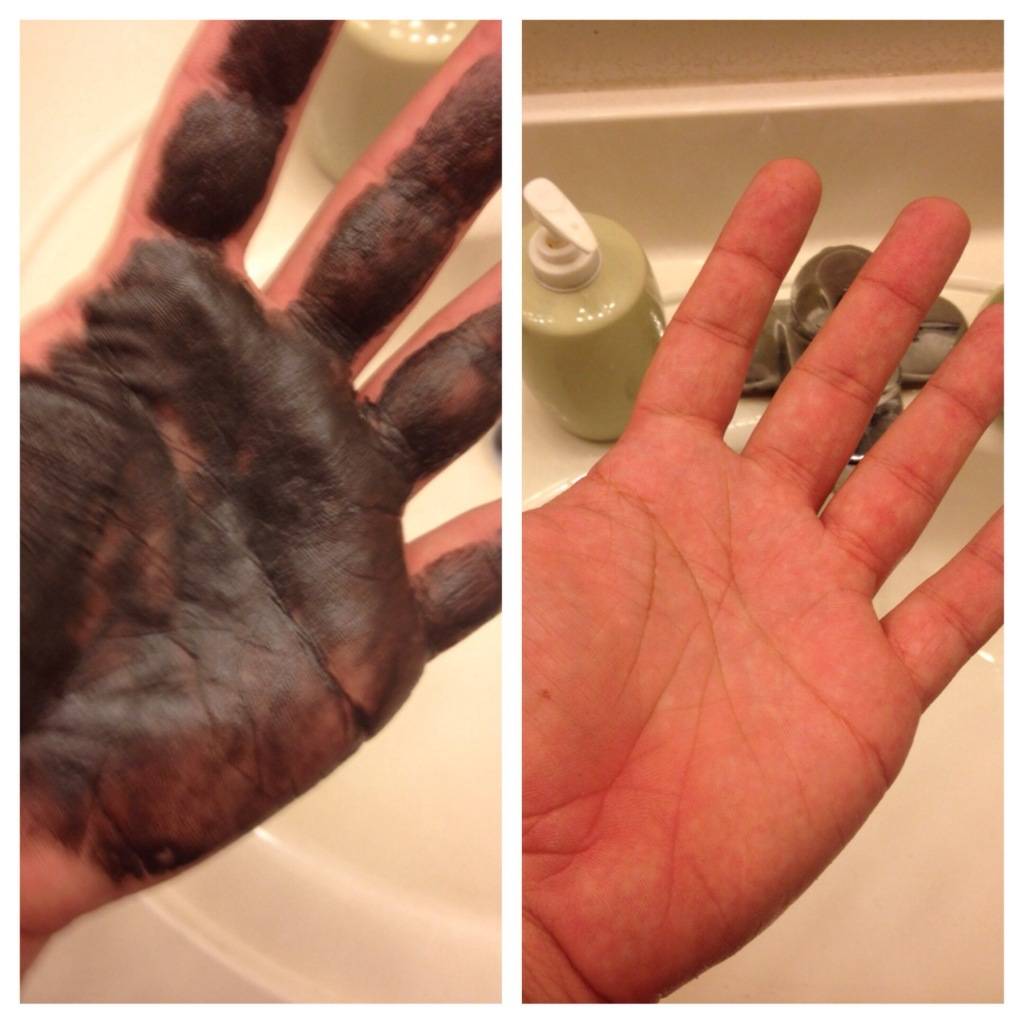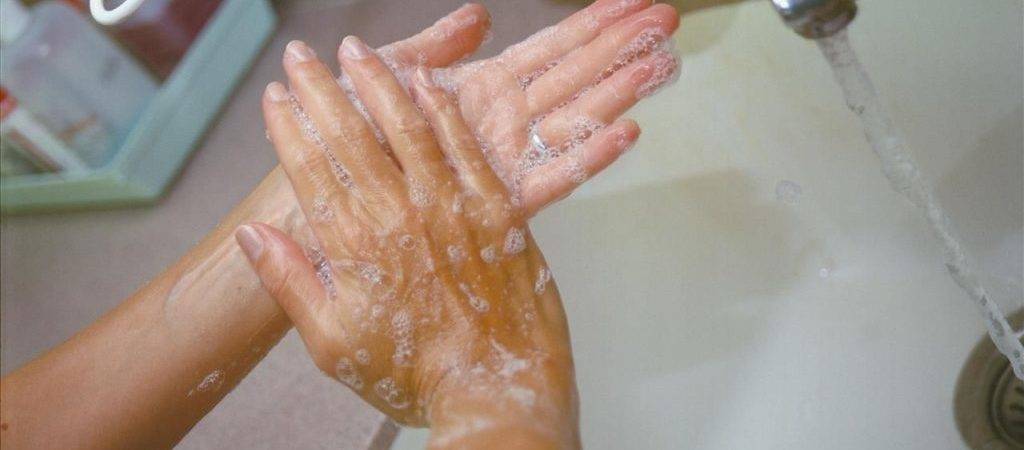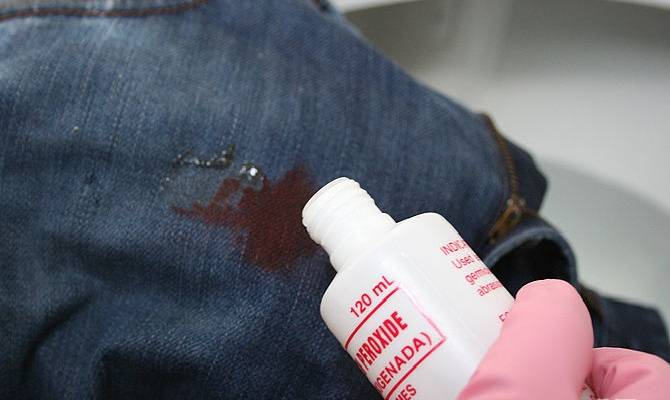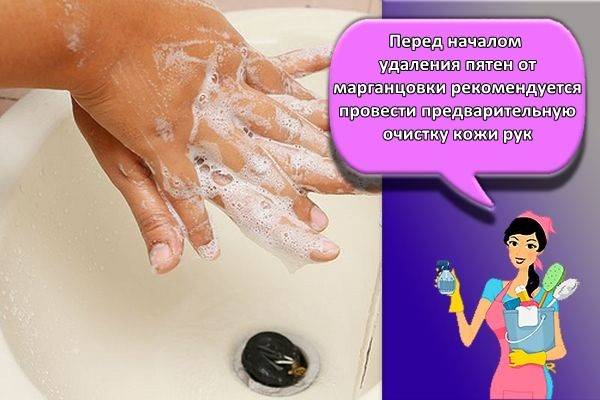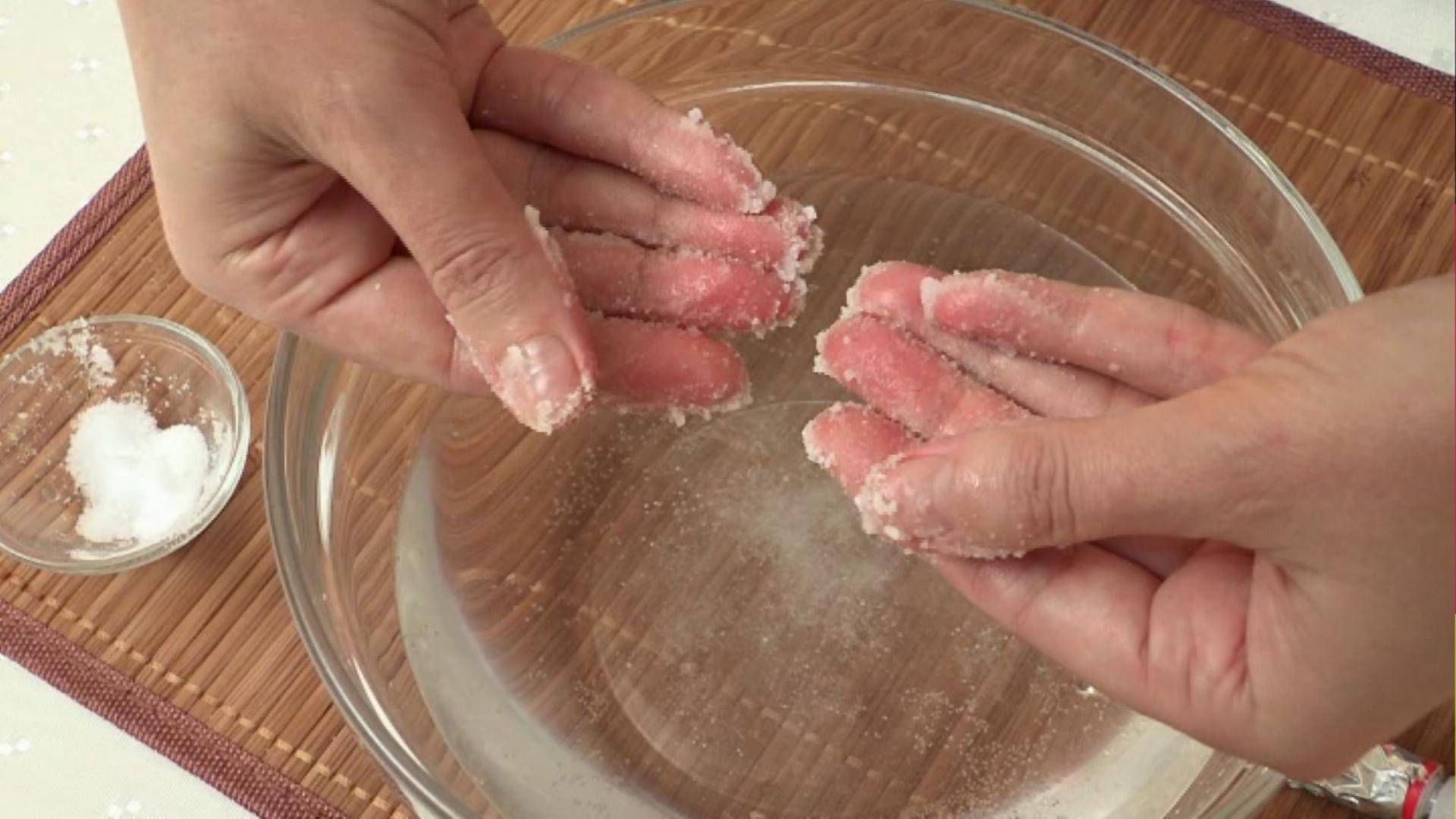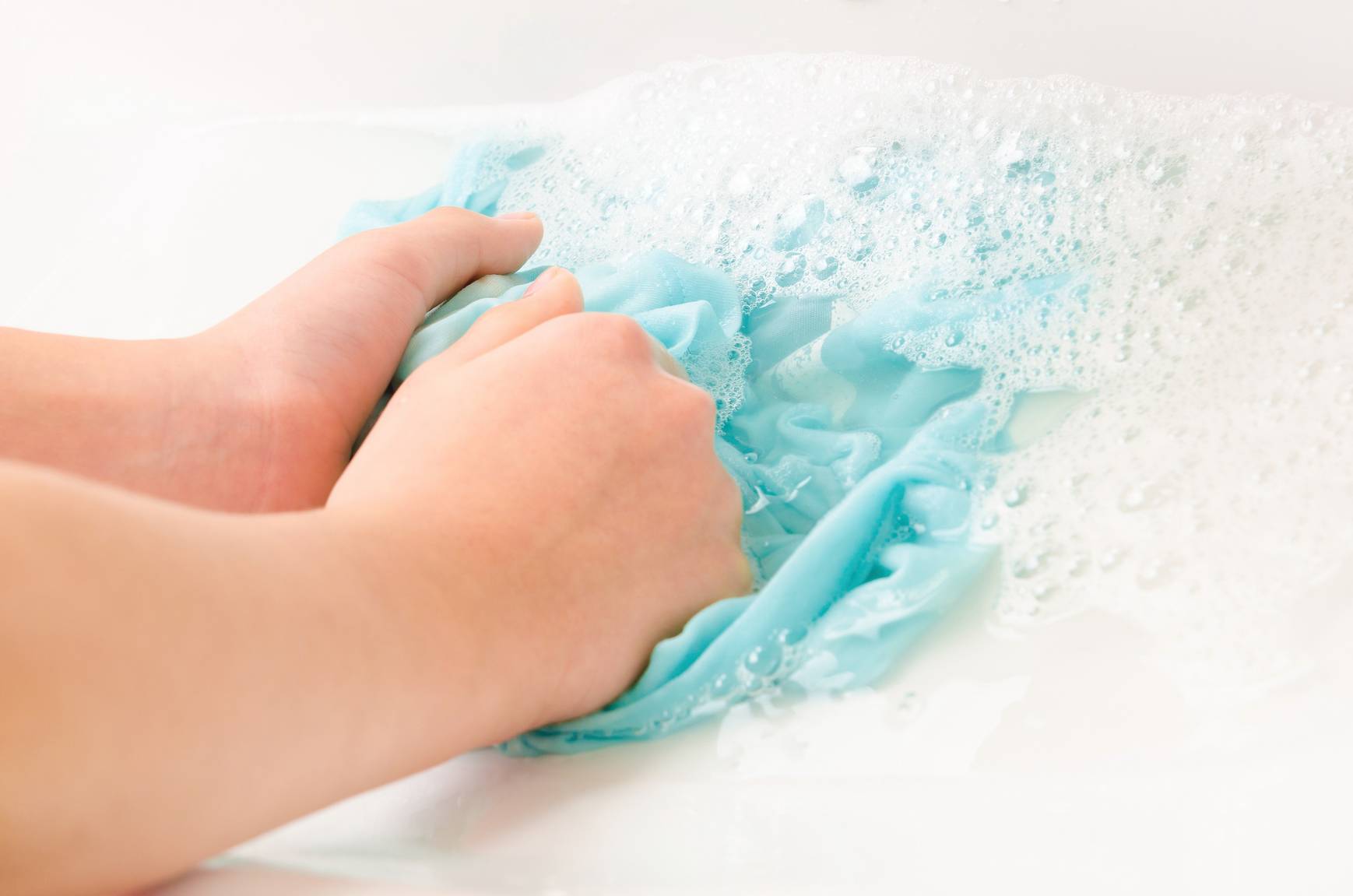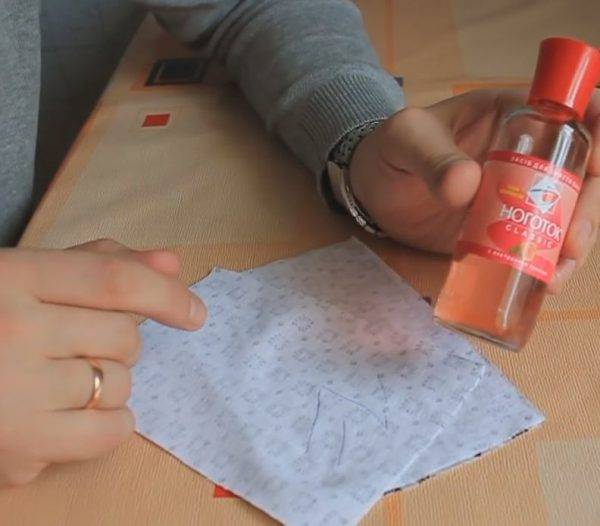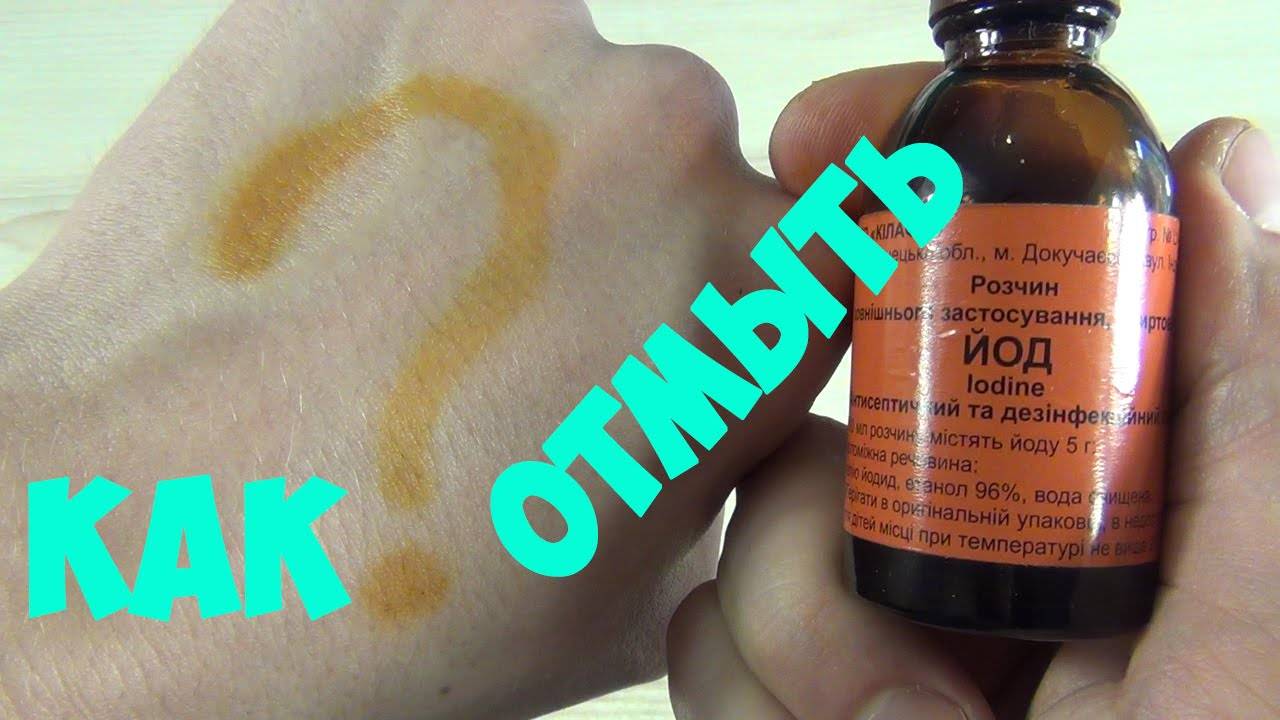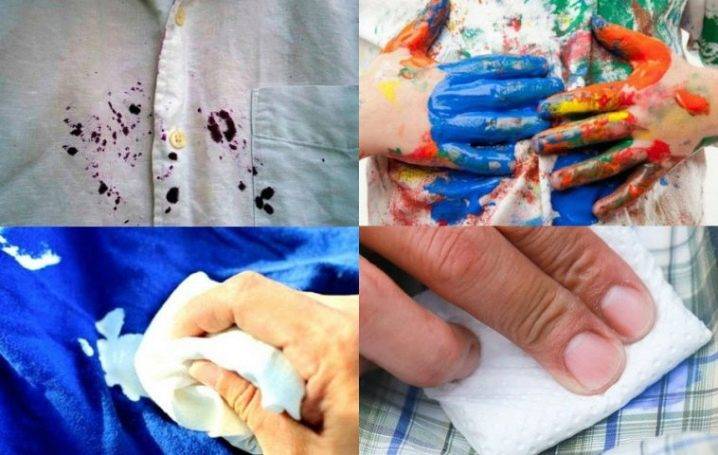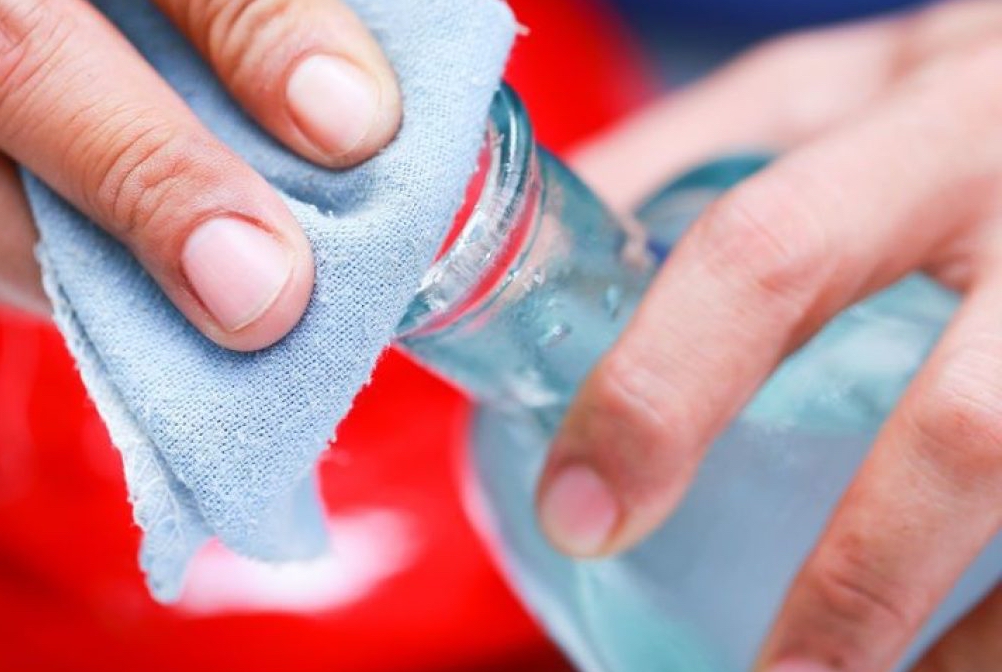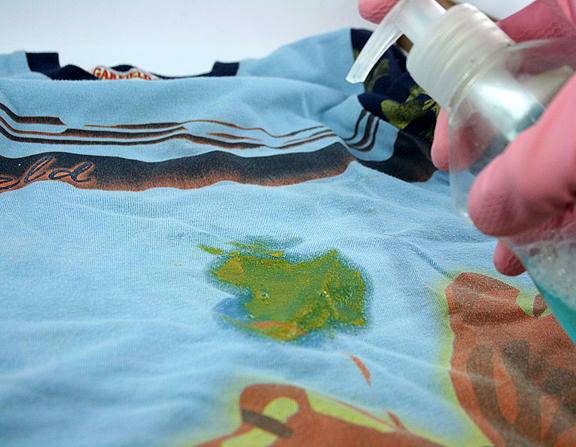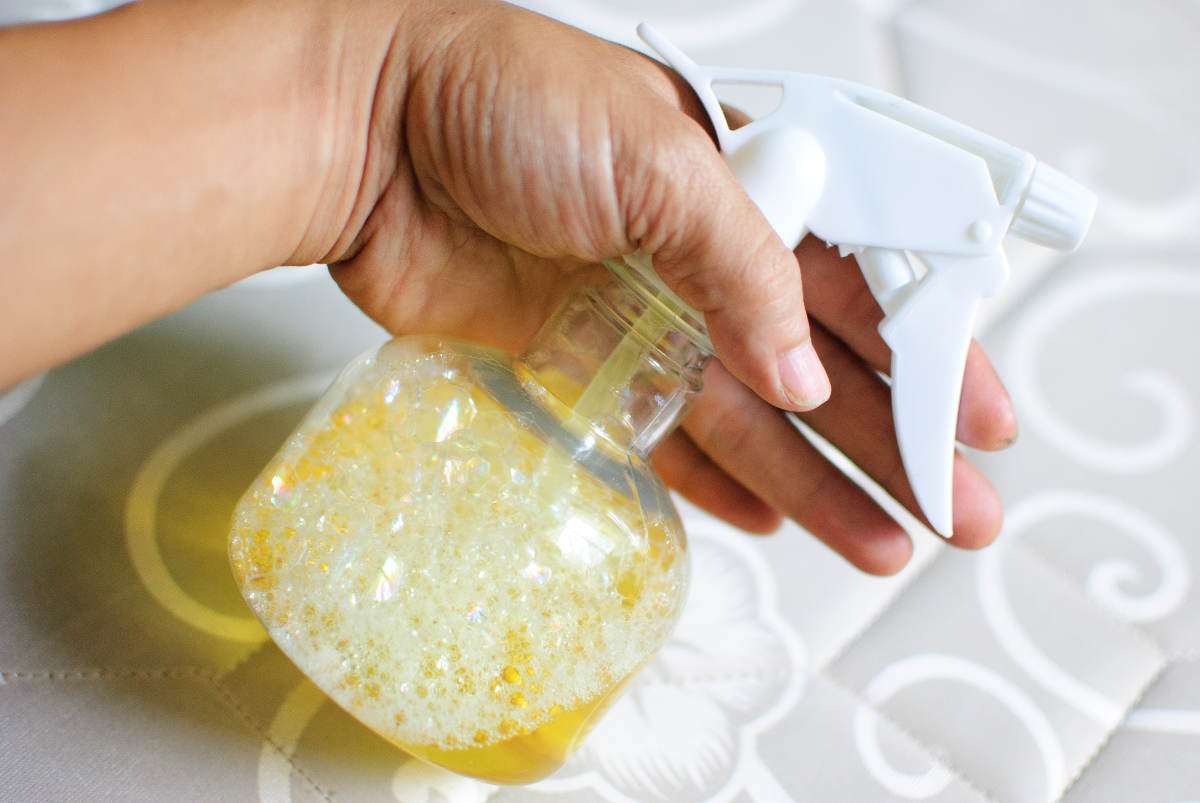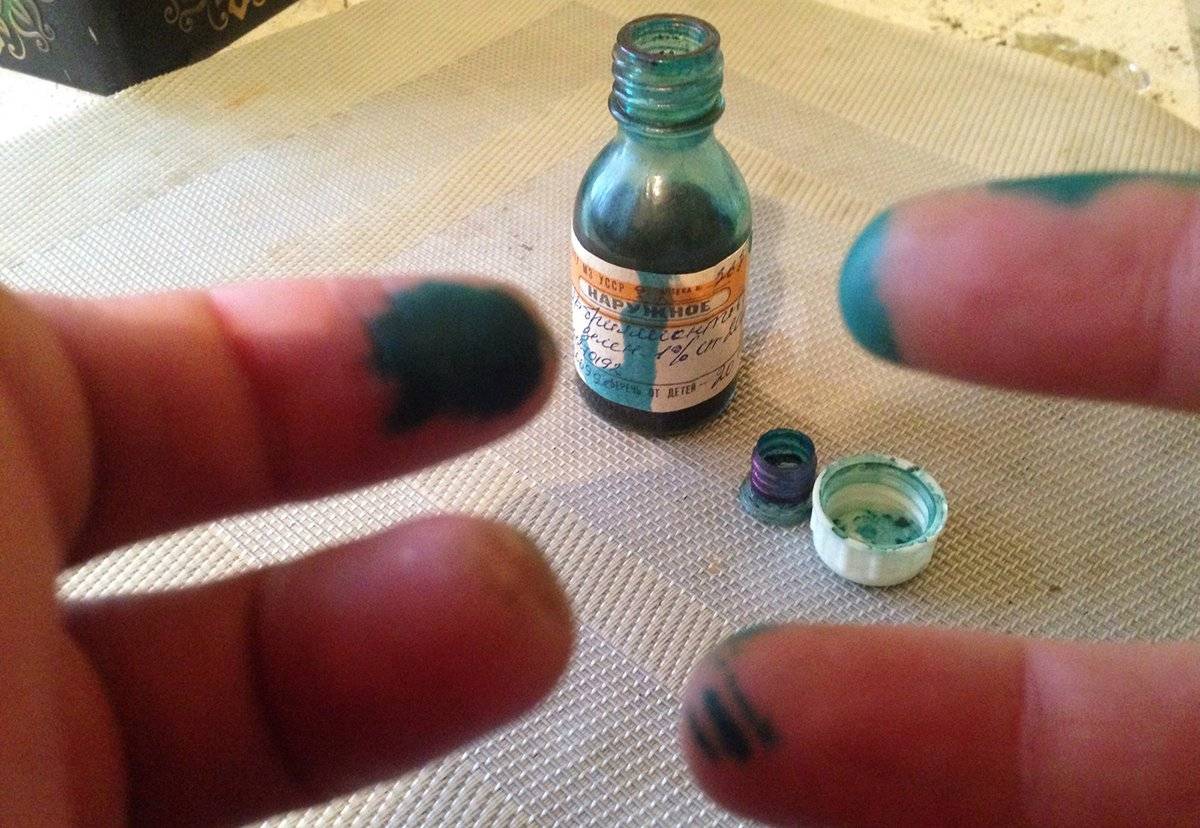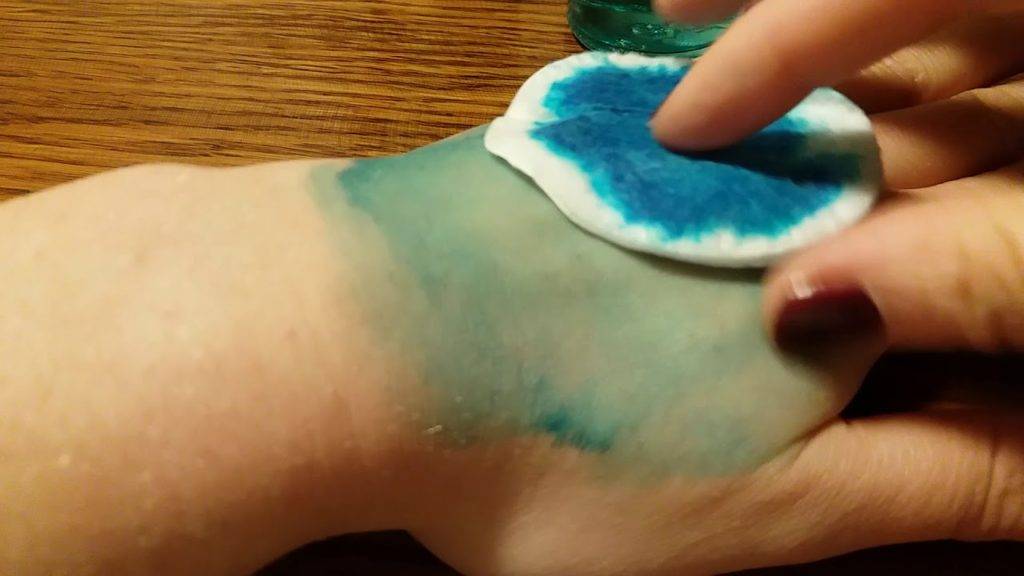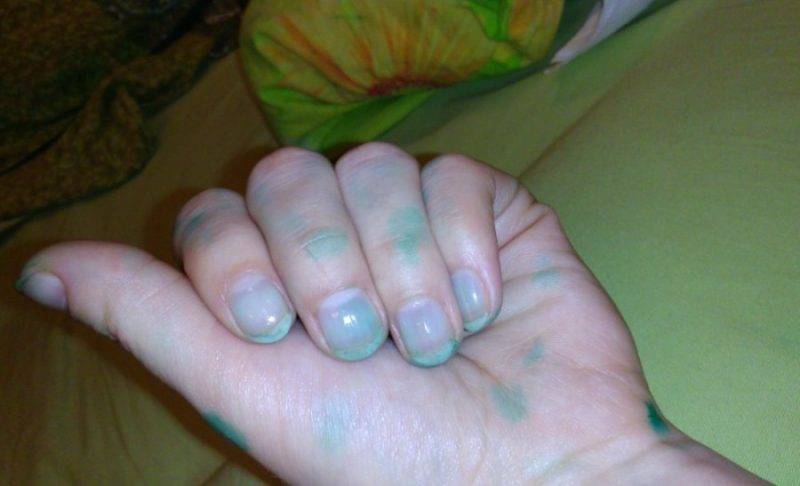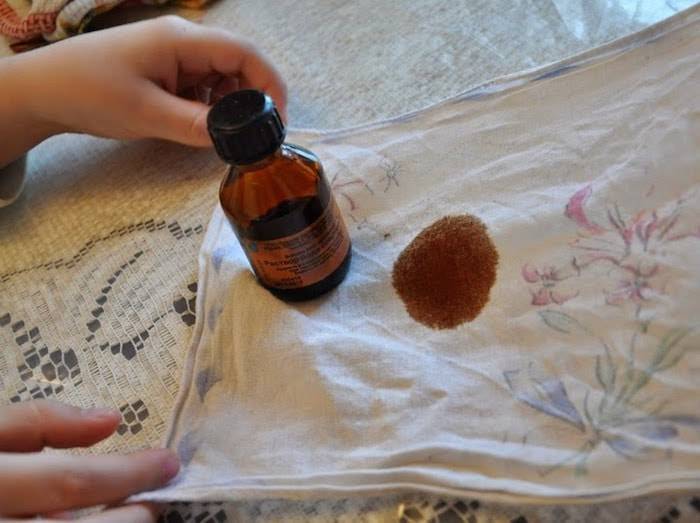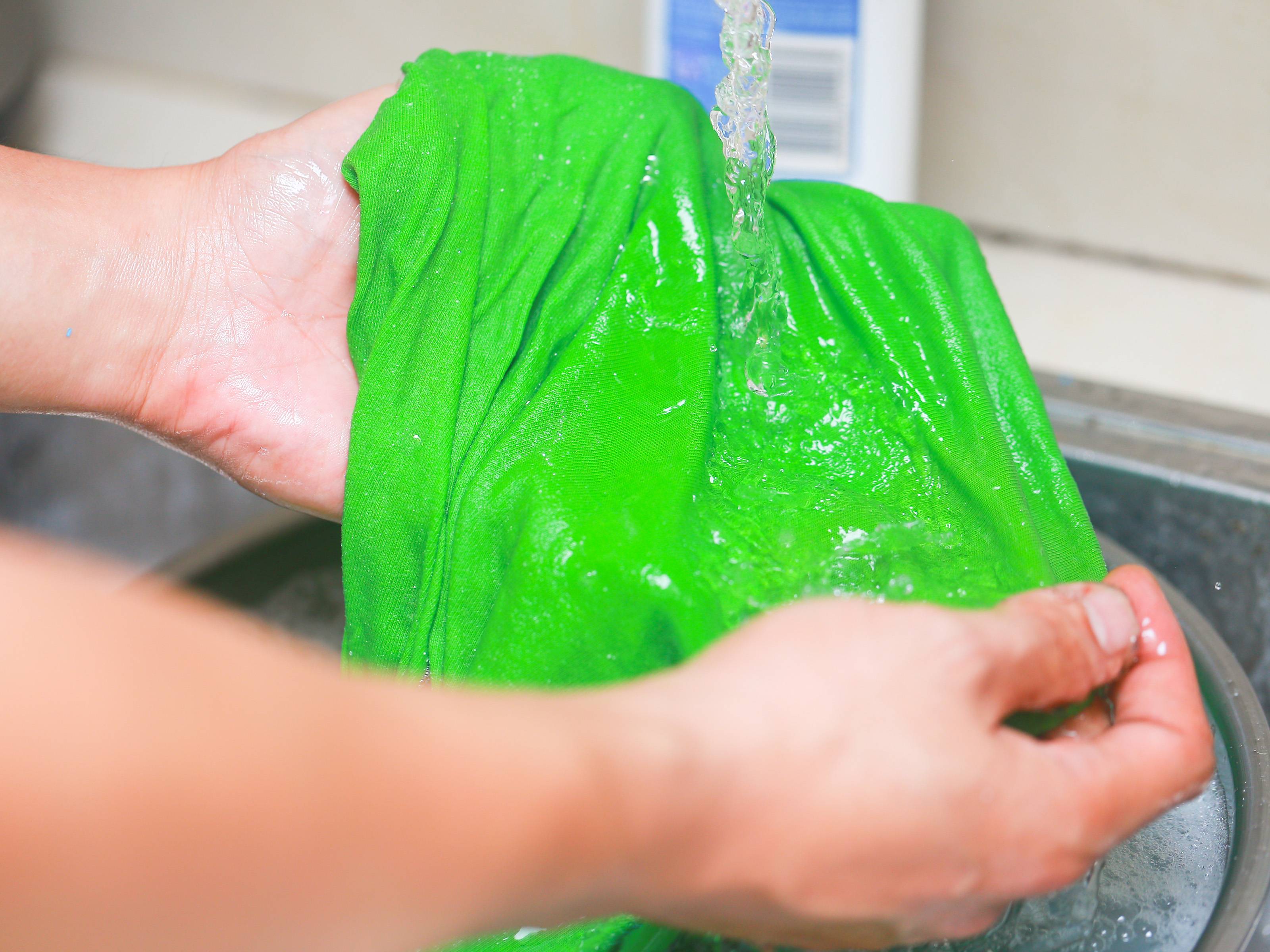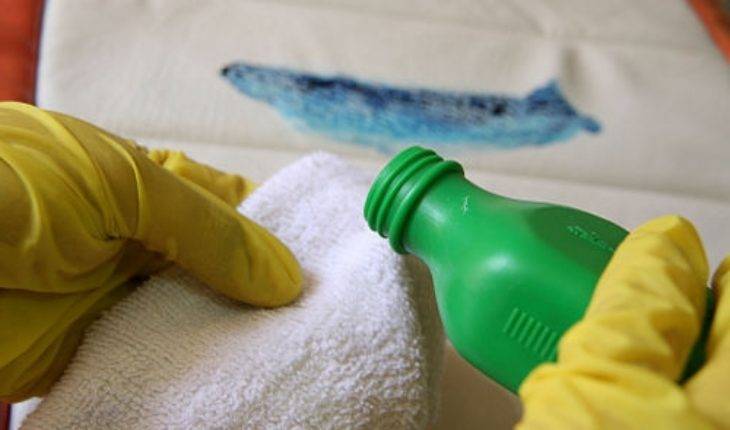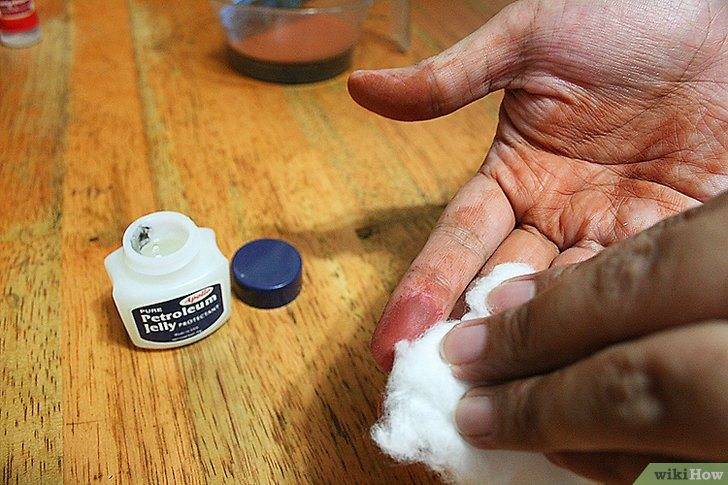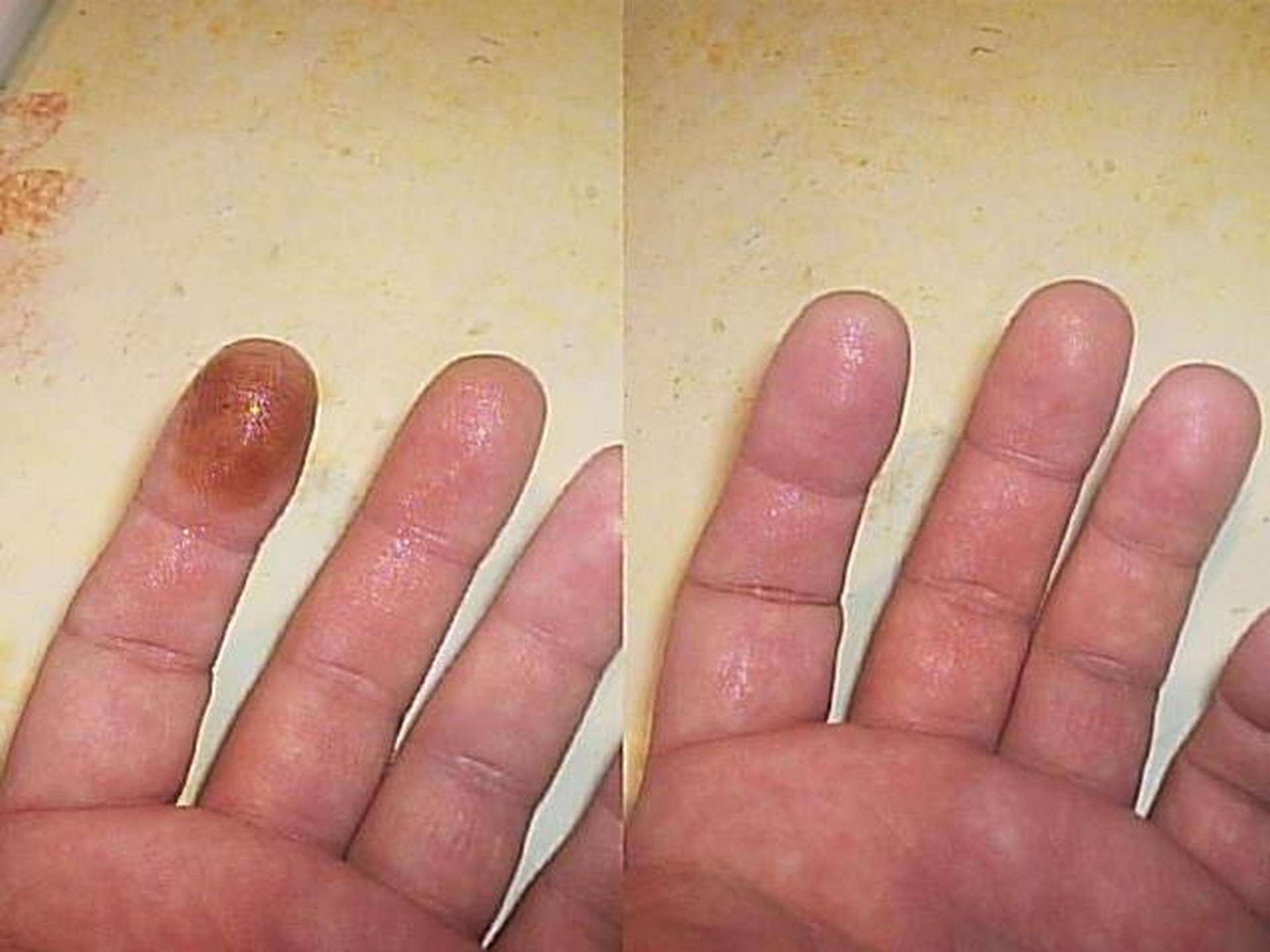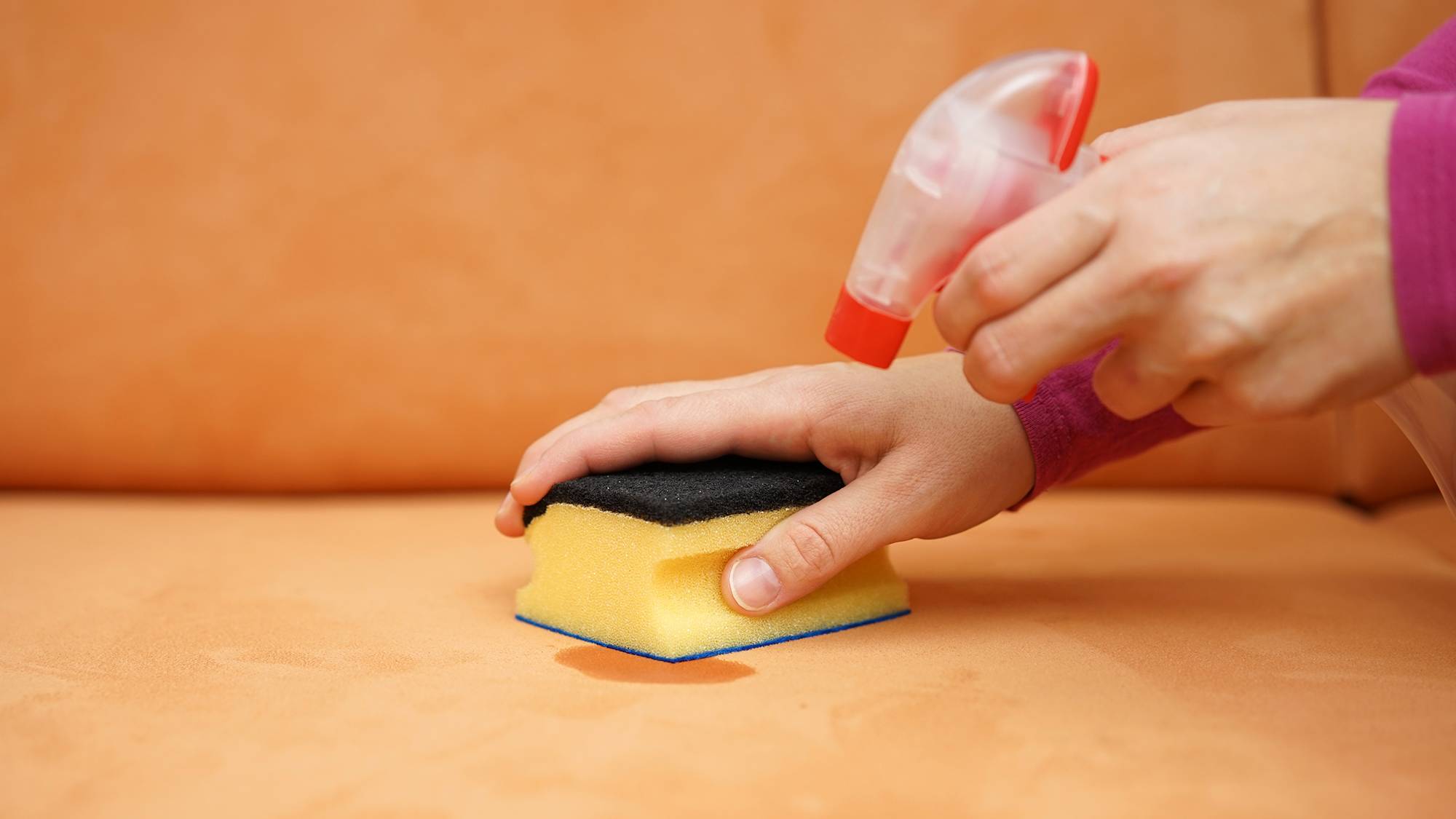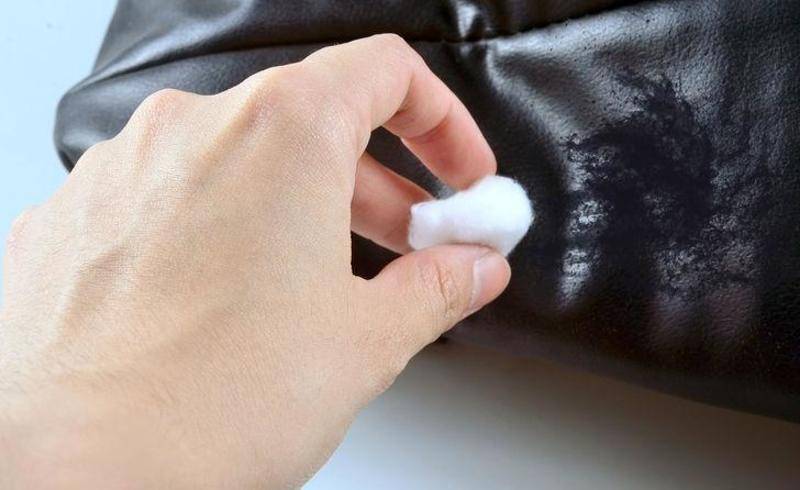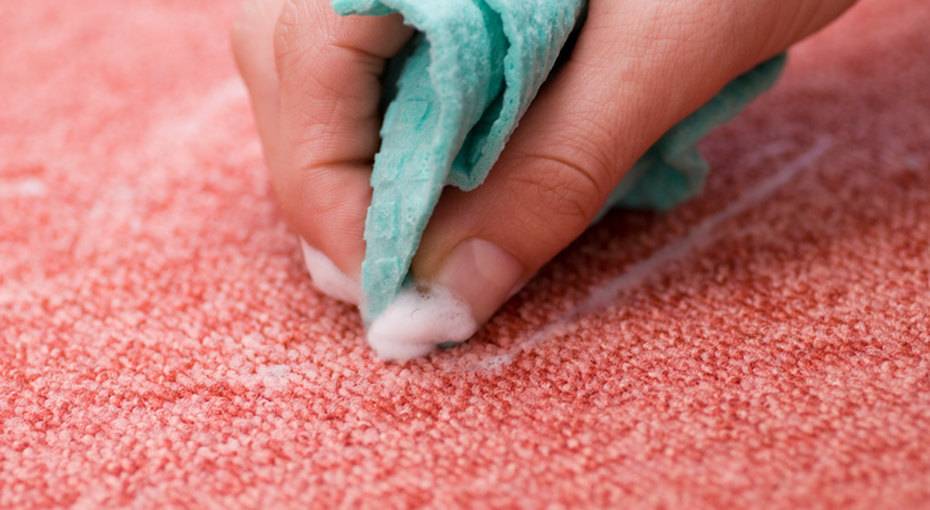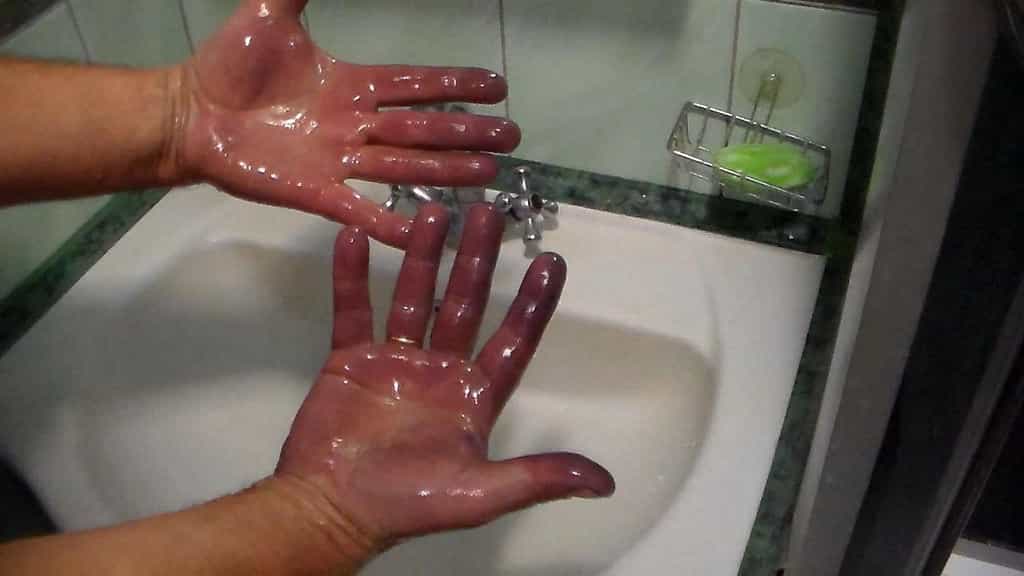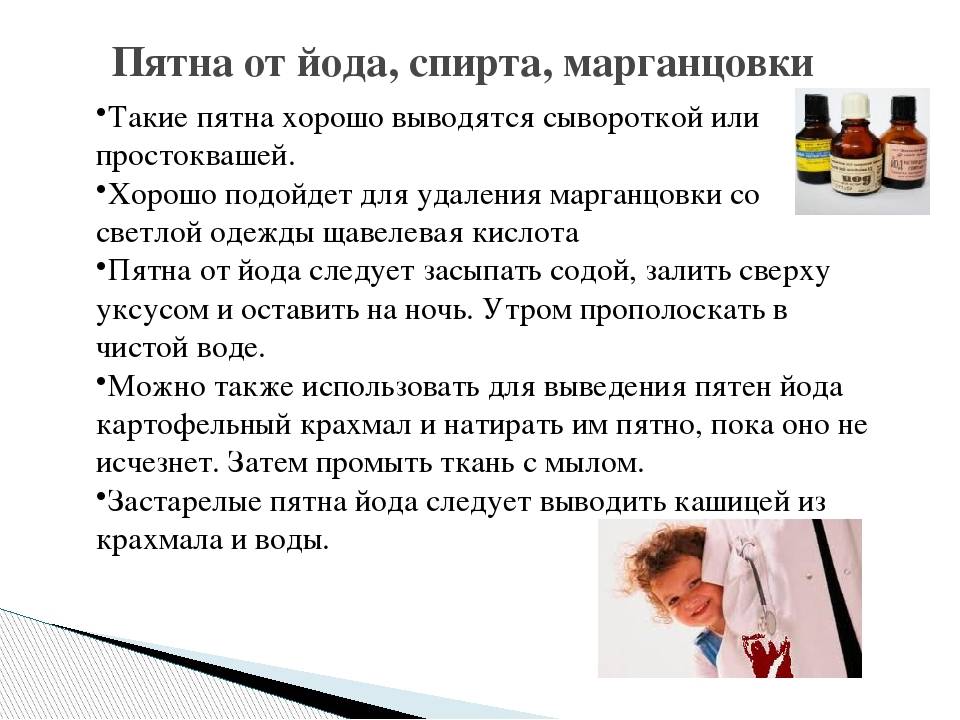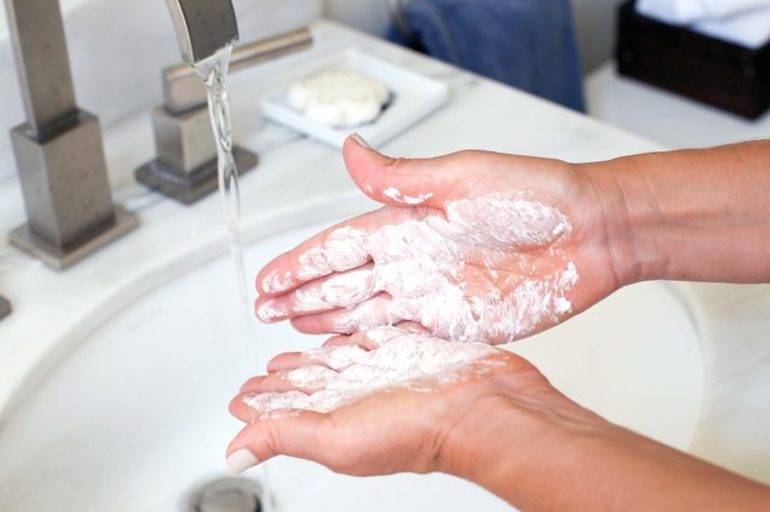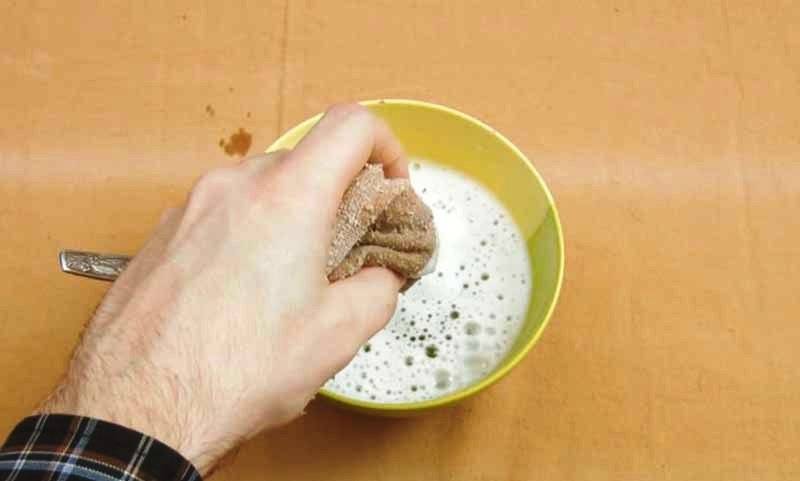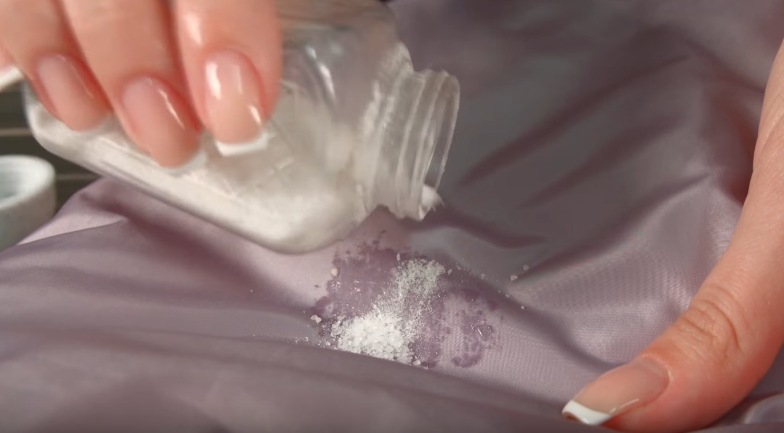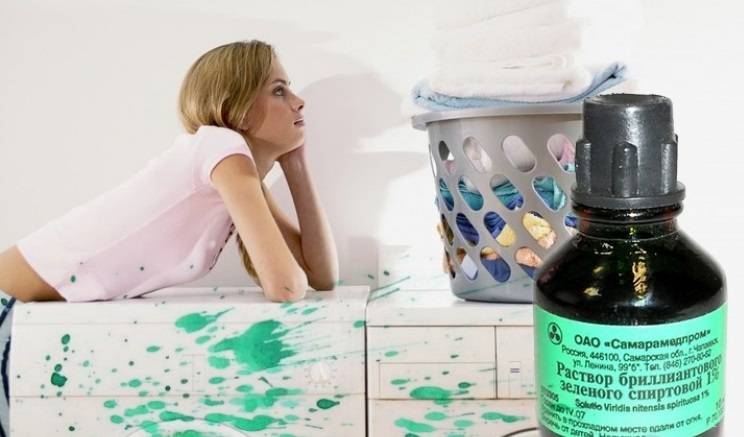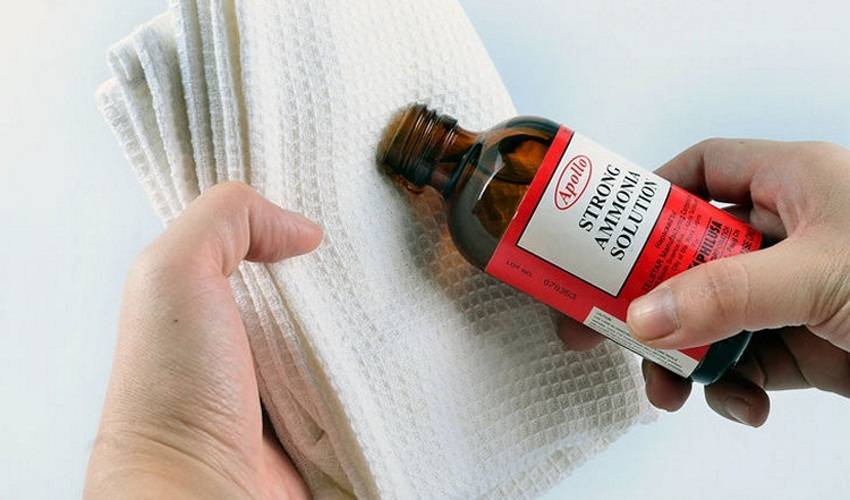Alternative methods for removing potassium permanganate
Many hostesses prefer to use folk methods in order to wash the potassium permanganate from the skin of their hands. Let's figure out what improvised means are able to efficiently wipe bright marks from hands.
A mixture of hydrogen peroxide and vinegar
If you want to wash off the potassium permanganate from your skin as soon as possible, you will need to do the following:
- mix in a small plate fifty milliliters of peroxide and nine percent table vinegar;
- wet a small soft cloth with the resulting liquid;
- rub the stains on your hands until they are completely washed off.
This tool washes other surfaces quite effectively. For example, if you use it to wash the floor, there will be no trace of untidy stains.

Ethanol
Alcohol-containing products dissolve potassium permanganate quite well. It is not necessary to use pure ethanol. The remains of the bright solution can be easily washed off using perfume, vodka or other strong drinks. The method of application is simple, just put a little alcohol-containing liquid on a cotton swab, and gently wash off the colored marks from your hands.
It is worth considering that the considered method is only suitable for cleansing skin that does not have burns, scratches and wounds. Also, alcohol-containing substances are strictly forbidden to be applied to the delicate skin of babies.
Lemon acid
Removing manganese with lemon is quite effective due to its chemical properties. The fact is that organic acid has good activity, therefore it quickly enters into a chemical reaction with potassium permanganate and removes its traces. To wash a lemon from your hands, you can use one of two methods:
- dissolve a packet of food additives in half a glass of slightly warmed water, and treat the problem area with an active liquid;
- cut the washed fresh lemon, and wipe off the stains with a slice.
Vitamin C
Ascorbic acid has a similar effect. The acid is sold at pharmacies in powder or tablet form. Before applying, it will need to be thoroughly dissolved in water. Then apply to the stained area. This solution should quickly wash the potassium permanganate from the skin. However, if you cannot get rid of the stains the first time, you can re-treat your hands.
Hydrogen peroxide
Peroxide is a very active compound. Therefore, it allows you to qualitatively wash the remains of potassium permanganate not only from the skin, but also from under the nails on the hands. To carry out a hygienic procedure, it is enough just to moisten a small cloth with an active liquid and treat the contaminated area.
It is worth remembering that peroxide has a good whitening effect, so it is good to use it to clean potassium permanganate from a bath or other white surfaces of a home interior. Also, to wash the plumbing from corrosive stains, you can use Whiteness or any liquids that contain chlorine.
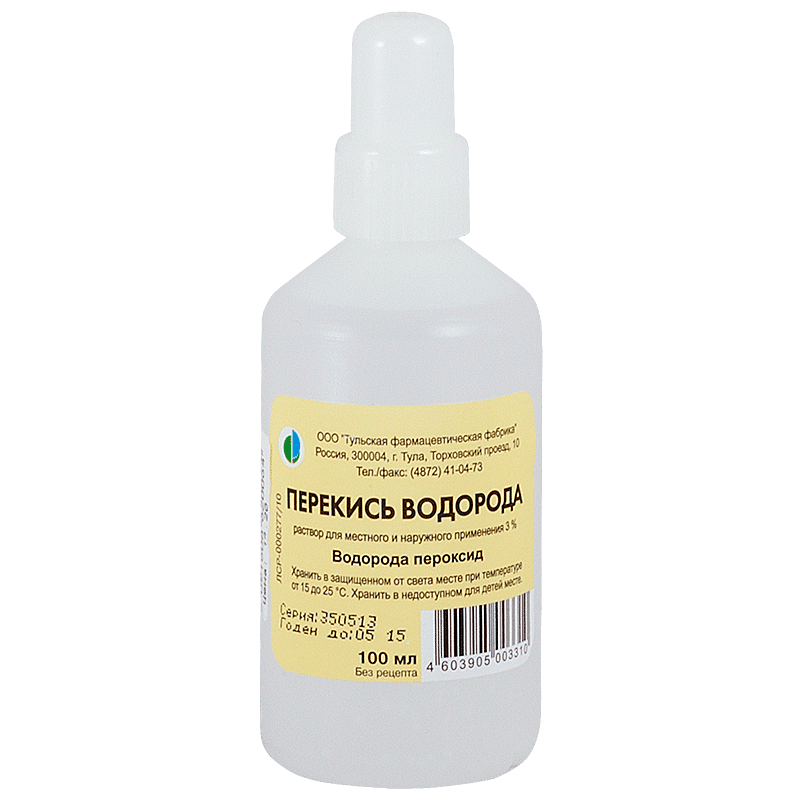
Ammonium sulphide
This salt, dissolved in ordinary water, very effectively copes with stains from potassium permanganate, instantly entering into a chemical reaction with it. It's great for cleaning bright spots off your hands. Only after using the active solution, it is imperative to wash it off the skin with hot water, otherwise you can get a serious burn or an allergic reaction.
Laundry soap
The soap solution is ideal for washing potassium permanganate even from very delicate and sensitive skin. To carry out a hygienic procedure, you will need to consistently perform the following steps:
- Grate a bar of solid soap with a coarse grater.
- Pour the resulting shavings with a little warm water, and mix the ingredients thoroughly.
- Add fifty grams of baking soda to the mixture.
- Add a few drops of eucalyptus oil. This will give the mixture a pleasant aroma and will also have a softening effect.
- Spread the resulting mass on the contaminated areas on the hands, and wait for it to dry completely.
- Wash off the product with clean water.
Also, with this mixture, you can clean any interior items at home, for example, a sofa upholstery or a plastic window.
Potassium permanganate: what you need to know about this substance
Potassium permanganate, or potassium permanganate, has the form of dark violet or red-violet crystals or a fine powder with a metallic luster.
Potassium permanganate dissolves in water in a ratio of 1 to 18, highly concentrated solutions are dark purple in color, and weakly concentrated solutions are pink.
According to its pharmacological action, potassium permanganate belongs to antiseptic and deodorant substances. The interaction of potassium permanganate with organic molecules leads to the formation of atomic oxygen and manganese oxide, denaturation of proteins.
Potassium permanganate, due to its pharmacological effects, is used in the treatment of ulcers and burns, for rinsing the mouth and throat, douching in gynecology and urology, and gastric lavage in gastroenterology. But potassium permanganate for acne is applied no less effectively if you follow certain recommendations for use.
Folk remedies
There are several formulations that effectively deal with pink spots. Proven helpers of housewives for years in the fight against traces of potassium permanganate are:
A solution of vinegar and hydrogen peroxide. The components are taken in equal proportions, one to one. With the help of cotton wool or a cotton pad, the resulting solution is applied to the skin.
Alcohol. A fairly simple way to remove unnecessary stains left by potassium permanganate. A napkin or cotton pad is abundantly moistened with alcohol and, with light pressure, is carried out in the traces of potassium permanganate. If necessary, the procedure can be repeated.
Lemon or citric acid. Cut a medium sized lemon into two equal parts. They wipe the area of the skin contaminated with potassium permanganate. Traces of lemon juice are washed off with soap and water. Instead of fruit, you can also use citric acid diluted in warm water. The proportions of the solution are one teaspoon of acid in half a glass of warm water.
Ascorbic acid solution. It can be purchased at the pharmacy. Rubbing the potassium permanganate stains with a solution several times a day will not leave a trace of them.
Hydrogen peroxide. Hydrogen peroxide has long been known for removing tough stains.
But you should work with it carefully. There is a possibility of getting a chemical burn if you use 3% hydrogen peroxide carelessly.
Ammonium sulphide solution. With the help of a solution of ammonium sulfide, diluted one to five with water, traces of potassium permanganate are also quickly removed. The resulting solution is carefully applied to the dirt, then washed off with warm running water.
White Spirit. White-Spirit, a solvent, can be found in almost every hardware store. Potassium permanganate stains can be visibly lightened by simply wiping them with a solvent applied to a cotton pad or cotton wool. After application, the remnants of the product must be washed off with warm water and soap.
Laundry soap. There is a safe and reliable remedy for removing potassium permanganate stains based on baby and laundry soap. For manufacturing you will need:
- laundry soap - 1 bar;
- baby soap - 1 bar;
- soda - 2 tablespoons;
- hot water - 400 ml;
- essential oil of eucalyptus, mint or any other - 2 drops.
Both bars of soap are grated and filled with hot water. The remaining ingredients are added to the resulting soap mixture.After thorough mixing, the resulting mixture is applied and well distributed on the areas of the skin colored with potassium permanganate. After ten minutes, the product is washed off. If the stain has not completely disappeared, the procedure is repeated.
How to wash off potassium permanganate from the skin using folk methods
There are a large number of folk methods for cleansing the skin from potassium permanganate, which are safe, but you need to adhere to the recommended dosage.
With alcohol
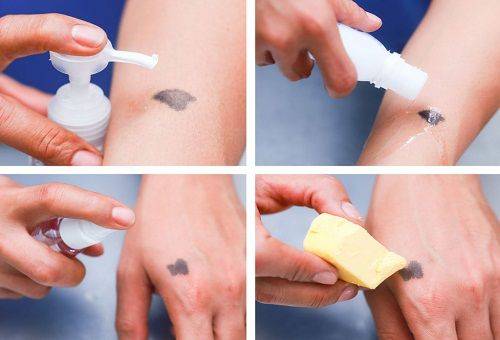
Take a cotton pad and moisten it with ethyl alcohol. Then, pressing down, start scrubbing the stain. Wash the area with soap and water. This way you will not erase everything in one go, so after 10 minutes have passed, repeat the procedure. There must be a lot of alcohol on the disc so that it is absorbed deep into the skin.
Hydrogen peroxide

Soak a cotton ball in peroxide and apply to the skin spot for 15 minutes. Wash everything off with soap and water and repeat the procedure until the result is achieved.
Citric acid
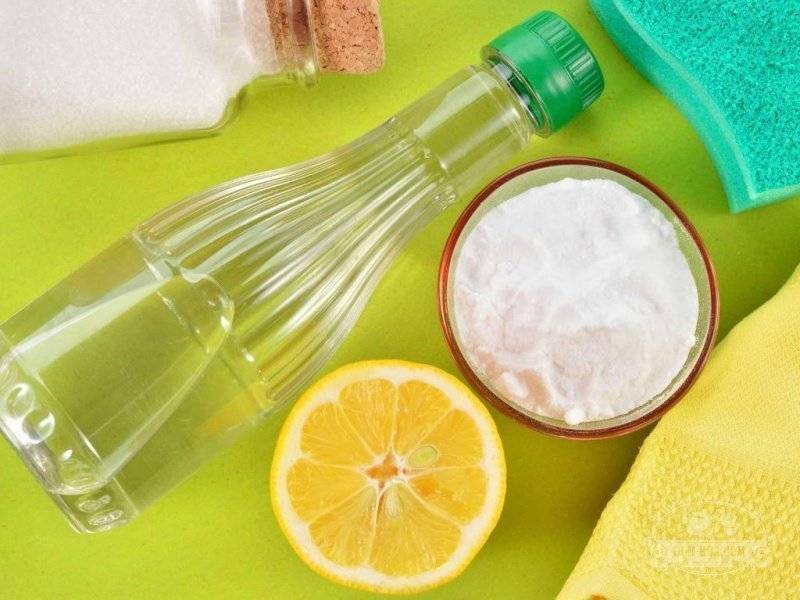
Cut off a wedge of lemon and apply on skin for 20 minutes. Then squeeze the citrus juice onto a cotton pad and scrub the potassium permanganate until you achieve the desired result.
Mustard

Sprinkle mustard powder on your fingers and rub it thoroughly into the stained area. Then rinse everything off with water. If there are any wounds or scratches on the body, then cover them with adhesive tape before the procedure. During the cleaning process, there is a slight burning sensation. To keep the skin from drying out, apply a moisturizer after the procedure.
Pumice

Pumice stone can only help if there are fresh potassium permanganate spots on the skin. Apply soapy water to the stained area and wipe with a pumice stone.
Clay
Clay can be used in several ways:
- We moisten the clay in water and wipe the potassium permanganate stain on the hand.
- We dilute the clay in warm water to get a thick mass. Then we apply it to the soiled area, apply a plastic bag and tie it with a bandage for 2-3 hours.
Vinegar

Dilute vinegar with water and moisten a cotton ball with it. Wipe the stained area by changing your tampon regularly. After the procedure, wash the skin with soap and water.
Ascorbic acid
Take 2-3 tablets of ascorbic acid and crush them with two spoons. Then pour into a glass of warm water and stir until completely dissolved. Soak a cotton pad or a piece of cloth in the solution and wipe the place with potassium permanganate. It will be difficult to completely cleanse the skin with this method.
Laundry soap
If you need to get rid of little visible potassium permanganate stains, then you can use ordinary laundry soap. Rub your palms to warm up and apply soap to them. Then wipe the stained area on the body until completely cleansed. The process is quite laborious, so it will take a long time to process potassium permanganate spots.
Ammonium sulphide
Moisten a tissue or cotton pad with the substance and carefully wipe the stained area of the skin. After the procedure, rinse everything off with water and apply a moisturizer.
Why is potassium permanganate stains difficult to wash
Potassium permanganate is one of the very aggressive substances that can cause chemical burns on contact with human skin. In this case, much depends on the concentration of the solution, since a weak solution of potassium permanganate will not cause such harm. Over time, the spots of potassium permanganate go off the hands themselves, thanks to the exfoliation of the scales of the skin. However, in some situations it is not possible to wait for this moment, and then home chemistry can come to the rescue. When potassium permanganate gets on clothes or furniture, bright, persistent stains remain on it, which can ruin the appearance of your favorite things. But even in this case, the situation is not hopeless.
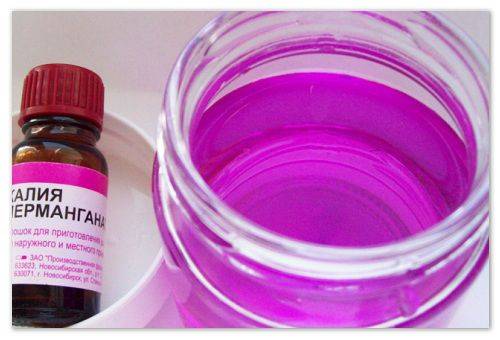
Potassium permanganate is a widely used antiseptic
Stages of preliminary preparation of hands before removing potassium permanganate stains
If you need to remove potassium permanganate from your hands, proper preparation will be the key to success.
- Pre-wash your hands under a stream of warm water.
- Use a pumice stone, gently treat dirty areas of the skin with it, without applying any special physical effort.
- After your hands are dry, proceed to remove the remaining dirt.
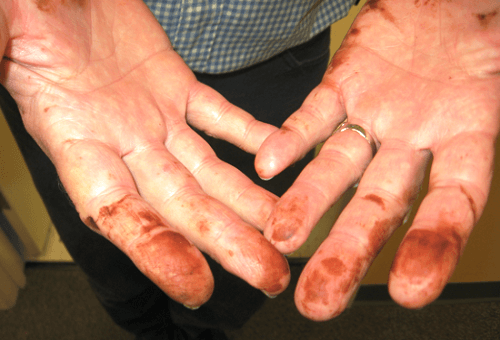
You can get rid of such pollution using folk methods.
Removing manganese stains on clothing, furniture, plumbing
Careless use of concentrated manganese solution can lead to contamination of clothes, furniture surfaces, and plumbing fixtures. In these cases, laundry soap does not always help, although sometimes its use is quite effective.
Ways to remove potassium permanganate stains from plumbing fixtures:
- Treat the surface with bleach, soak for about 40 minutes, rinse.
- 10% solution of one of the acids: oxalic, acetic, citric, apply to the contaminated area, moistened abundantly, hold for 5 minutes, rinse. Repeat the procedure if necessary.
- Moisten the stain with a solution of equal parts methanol (wood alcohol) and 6% -9% vinegar, rub and rinse.
- Mix hydrogen peroxide and citric acid (2: 1), apply on a fresh (old) stain, let stand for about ten minutes, rinse.
- To remove potassium permanganate, which did not have time to dry, the composition will help: rub laundry soap (200 g), add hot water (1 liter) and 100 g of baking soda or soda ash. Treat the plumbing, let stand 10 minutes, rinse.
- Add 2 tbsp to the previous composition. tablespoons of ammonia, cool, add mustard (1.5 tbsp. l), apply to a dirty area, rinse off after 10 minutes.
- Rub the dirt on acrylic surfaces with fine-dust sandpaper, then rub this area with a special paste (available from construction departments).
- The use of Domestos is quite effective on various coatings of baths and sinks.
Removing potassium permanganate on clothes:
- A universal remedy for any fabric: moisten the stain with lemon juice, rub, stand for 10-15 minutes, wash the item.
- For thin fabrics, kefir or yogurt is suitable: soak the contaminated part of the clothing for 6 hours, then wash the product on your hands.
- White and light-colored clothing: treat the contaminated area with a gruel of water and baking soda, let it stand for at least 6 hours, rinse and wash the product.
- Denim: Mix hydrogen peroxide with citric acid (1: 1), moisten the dirt, stand for about 10 minutes, rinse, wash the item.
- The drug Antipyatin can be used according to the instructions for the drug to various types of tissue.
Removing traces of manganese from various surfaces:
- Paper: moisten the stain with water, then treat with bleach, after an hour remove the liquid with a soft sponge, let the paper dry and iron with a hot iron if necessary.
- Floor, dishes: dissolve a piece of crushed laundry soap and a piece of baby soap in a liter of hot water, add soda (2 tbsp. L) and essential oil (2-3 drops), process the trace, rinse.
- Solvents are suitable for removing dirt on linoleum, wooden floors, dishes. Check the action of the product before use.
- For a variety of floors, you can use Domestos Sanitary Ware Cleaner, a composition of equal parts hydrogen peroxide and citric acid, taken in equal parts.
- For upholstered furniture, the same products are suitable as for clothes, a product based on laundry soap (described above), a mixture of equal parts of citric acid and hydrogen peroxide. Apply the preparation on contamination, rub the stain, leave for a few minutes. Blot the remaining liquid with a towel. Before use, test the effect of the drug on the upholstery fabric in an inconspicuous area.
- To remove stains on carpet, carpet, you can use the listed mixtures for clothes, Vanish for cleaning carpets, Vanish for removing stains.
Any product is more effective if used on fresh dirt.
First aid
The prognosis of trauma treatment directly depends on the timely provided first aid to the victim.The provision of emergency assistance to a child and an adult does not differ significantly.
A burn from potassium permanganate on the skin up to degree 3 should be washed with running water at room temperature for 25-30 minutes, before that, remove clothes from the injured area of the body. Burns of 1 and 2 degrees do not require medical treatment; with proper care, they will heal without a trace in 1-3 weeks at home. To prevent mechanical injury to the burned area, you can apply a bandage with panthenol, levomekol, homemade products or anti-burn sprays from a pharmacy. As an antidote, a weakly alkaline solution is used, consisting of 2 tsp. baking soda and 1 liter of water. A 3rd degree burn after washing should be covered with a damp cloth (in no case with cotton!) And wait for the arrival of an ambulance.
Severe burns of 3 and 4 degrees are treated only in medical institutions! Folk recipes are contraindicated.
Eyes with chemical burns should be rinsed with running water for half an hour. After that, rinse with 5% tannin solution or strong brewed cold tea, drip drops with antibiotics. Be sure to call an ambulance. Further treatment will be prescribed by a doctor.
In case of a burn of the mucous membranes of the genital organs, first aid consists of abundant rinsing with running water, douching with a solution of soda (2 tsp per 1 liter of water). Be sure to call a doctor.
First aid for oral poisoning is to remove the chemical from the esophagus and stomach in order to prevent intoxication of the body. Give the victim to drink an alkaline solution of 2 teaspoons of baking soda per 1 liter of water as an antidote. To neutralize manganese, an aqueous solution of hydrogen peroxide (100 ml per 2 l of water) is used, the procedure is repeated until the contents of the vomit acquire a light shade and transparency. After washing the stomach, the oral cavity, the patient is given castor oil to remove chemical residues through the colon, activated charcoal in a dosage of 1 g per 1 kg of the victim's weight. Food poisoning should be treated in a hospital under medical supervision.
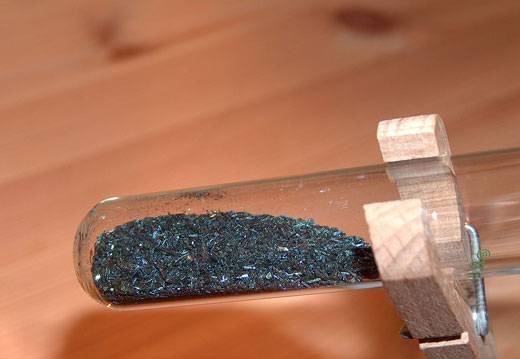
Due to the fact that the child's body has a softer skin, a smaller integument area, a fast metabolism. The consequences of poisoning for a child will be much more serious than for an adult, even with a lower dosage of a toxic substance. As soon as it is noticed that the child has been poisoned or burned, you need to call an ambulance, start actions to eliminate the poison from the body. A burn from potassium permanganate in a child should be shown to a doctor even if a 2 degree severity is suspected. Internal damage will harm the child much more in a short time, since the absorption of the stomach, its metabolism is higher, the circulatory system will carry the poison through the organs and into the brain much faster. This is the danger of poisoning and burns for children. It is much more difficult to cure the consequences due to the immaturity of the organs.
Radical methods of dealing with stains
We received a chemical burn of the skin, which means that we colored the pigment of the epidermis, therefore it is necessary to use aggressive agents that have a powerful effect. Here is a list of substances that will certainly help remove dark stains from the skin of the hands and feet.
1. Acids. Acidic substances burn out the particles of the skin, discolor them. Home remedies containing acids are known to everyone:
- vitamin C. Regular Aspirin cleans stubborn dirt well. It is necessary to crush the Aspirin tablet, dissolve it well in water. Moisten a cotton pad with the resulting solution and systematically wipe the stains;
- lemon acid. Dissolve a few granules of citric acid powder in a tablespoon of water, apply the liquid to the skin of the feet or hands. Try to wipe off the stains, they should definitely turn pale. If you have fresh lemon at home, you can try to remove the stain directly with a lemon wedge;
- acetic acid.It is not recommended to use the essence, there is too high a chance to add a severe burn of the skin to a dirty spot. Take 9% vinegar - about one tablespoon - add to it a few drops of hydrogen peroxide, a couple of drops of water. Use the resulting solution and a piece of cotton to quickly erase the stains.
The product is unsafe, if you feel a burning sensation and itching, it is better to stop the procedure immediately, and rinse the mixture under running water.
2. Alcohols. Alcohols are versatile stain removers, but not very fast-acting. Take a cotton pad, moisten it in the alcohol available in the house - ethyl, formic, boron - and wipe the dirt thoroughly.
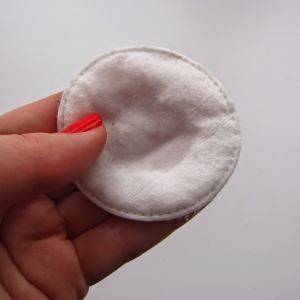
3. Solvents. An effective method has the disadvantage of a pungent odor after the cleansing process. However, solvents cope well with stains, but it is more advisable to wash the stains with technical means: acetone, white spirit.
4. Household chemicals. Corrosive chlorine-containing products perfectly whiten fabrics, let's try to wipe off the skin:
- white. You can use whiteness to cleanse the skin surface quickly and effectively. We strongly advise against using the product in its pure form, skin burns will be guaranteed. Unpleasant peeling will also be added to the black-lilac spots;
- sodium hypochlorite and chloramine. The product is used for disinfection of medical and health institutions. The problem of staining with potassium permanganate is not uncommon for doctors, and if it occurs in the workplace, use a solution of disinfectant material. Hot on the trail, you can effectively remove lilac stains with a chlorine solution.
The degree of skin injury
In case of chemical injuries, it is important to determine the level of damage, because further actions will depend on this. The classification of burns is as follows:
- First degree. Redness is weak, almost imperceptible swelling and pain;
- Second degree. The edema becomes more noticeable, the skin acquires a bright red color, and blisters with a transparent liquid begin to form at the site of the injury, the painful sensations bring considerable discomfort;
- Third degree. Deep tissue is affected, the resulting vesicles will be filled with cloudy, dark or bloody fluid;
- Fourth degree. Muscle, bone, adipose tissue, tendons and ligaments are injured.
A burn with potassium permanganate most often acquires the 1st and 2nd level of damage.
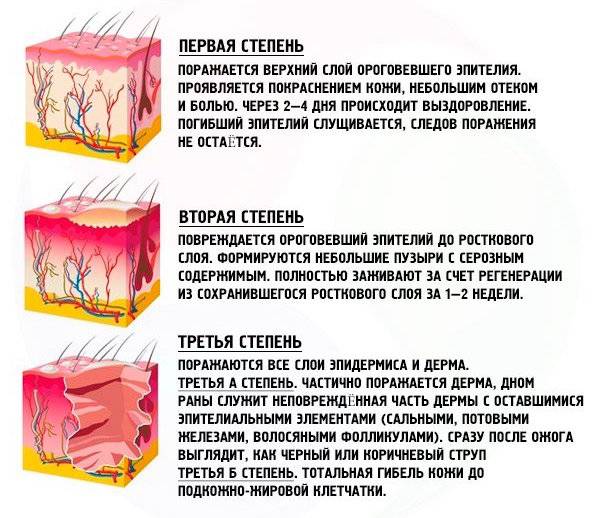
How to wash potassium permanganate off your hands: 16 best remedies and ways to wipe stains off your skin
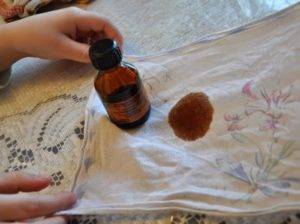
How to quickly wash potassium permanganate from the skin of your hands? Potassium permanganate stains appear very quickly on the skin. The epithelium absorbs the substance into the skin and is not washed off for several days. There are several methods for removing this type of contamination. They use folk remedies and chemical compositions.
Why is it not washed off with water
Potassium permanganate solution interacts with the upper layers of the epithelium. It penetrates into deep layers and is absorbed very quickly. Therefore, such stains cannot be washed off with water. Over time, the concentration of the substance in the epithelium decreases, and the pollution disappears. But this process takes 3 - 5 days.
To speed up the disappearance of unpleasant brown areas, it is recommended to use folk remedies and chemical solutions.
Important! With a high concentration of potassium permanganate solution, there is a possibility of getting burns
Preparing to uninstall
Before you start wiping off the contaminated skin, wash your hands thoroughly under water using laundry or ordinary soap. To improve the result, resort to pumice or a dense sponge. The procedure is repeated until brown water stops flowing from the hands.
Folk remedies
Folk remedies in the fight against potassium permanganate spots on the skin of the hands are quite effective. They are not harmful to health and help to cope with the problem.
These methods include:
- hydrogen peroxide;
- acetic acid;
- ethanol;
- citric acid;
- ascorbic acid;
- mustard;
- clay;
- laundry soap.
Hydrogen peroxide and vinegar
Acetic acid and peroxide are mixed in equal proportions, rubbed into the skin. The spots gradually become lighter and then disappear. After treatment, hands are washed with soap.
Lemon acid
2 tablespoons of dry powder is mixed with 1 glass of warm water. The solutions are wiped off the stained area. Then the skin is washed with soap and water.
Vitamin C
2 - 3 tablets are crushed and dissolved in water. The mixture is used to treat the soiled parts of the hands. Acorbinka is able to lighten stains, but does not completely eliminate them.
Hydrogen peroxide
Use a 3 or 6% solution. Wipe dirt with a moistened cotton pad or gauze. Stains can be completely removed after 3 - 5 treatments. Each time they will become lighter.
Lemon juice
A fresh lemon is cut in half and squeezed out of it. Then it is applied to the required areas. Rub thoroughly into the skin, wait 10 minutes and rinse off. This procedure is repeated several times.
Laundry soap
The bar is rubbed on a fine grater, dissolved in warm water. They put their hands in there and stand for 20 - 30 minutes. This is one of the most effective methods.
Mustard
Dry powder is applied to hands and scrubbed well, then washed off with cold water. During the procedure, there is a burning sensation. After rinsing, the skin is lubricated with a moisturizer.
Important! If there are scratches or other injuries on the hands, they are sealed with a plaster before starting treatment
Clay
Dry clay is mixed with water, applied to areas stained with potassium permanganate. Give time to dry. Withstand 20 minutes, rinse with water, apply a moisturizer.
Pumice
It takes a long time to wipe off stains with pumice. It is necessary to wash the contaminated areas with water every hour during the day and treat with a pumice stone.
Acetic acid
Table vinegar can burn your skin. Therefore, wipe the stains with a dampened cloth, and then wash your hands with water. The procedure is repeated 2-3 times.
Chemicals
To speed up the process of getting rid of potassium permanganate stains, chemicals are used. These include:
- White - alcohol;
- White;
- Sodium hypochlorite;
- Chloramine.
These formulations are used with caution, as they can cause burns on the skin.
White - alcohol
It is a versatile solvent that quickly removes any substance. Moisten a piece of cloth and wipe the skin. After the procedure, be sure to wash your hands with soap and apply a moisturizer.
Advice
If it is necessary to wash stains of potassium permanganate, several rules must be followed:
- It is recommended to use rubber gloves to prevent manganese from getting on your hands.
- If you receive a solution of burns, seek medical attention.
- Do not use substances to remove stains that can cause an allergic reaction.
- It is not recommended to use unknown and little-known chemicals.
- After wiping off, apply a moisturizer.
- Any damage and scratches on the hands are sealed with a plaster.
- To improve the effect. After processing, wash your hands with laundry soap.

